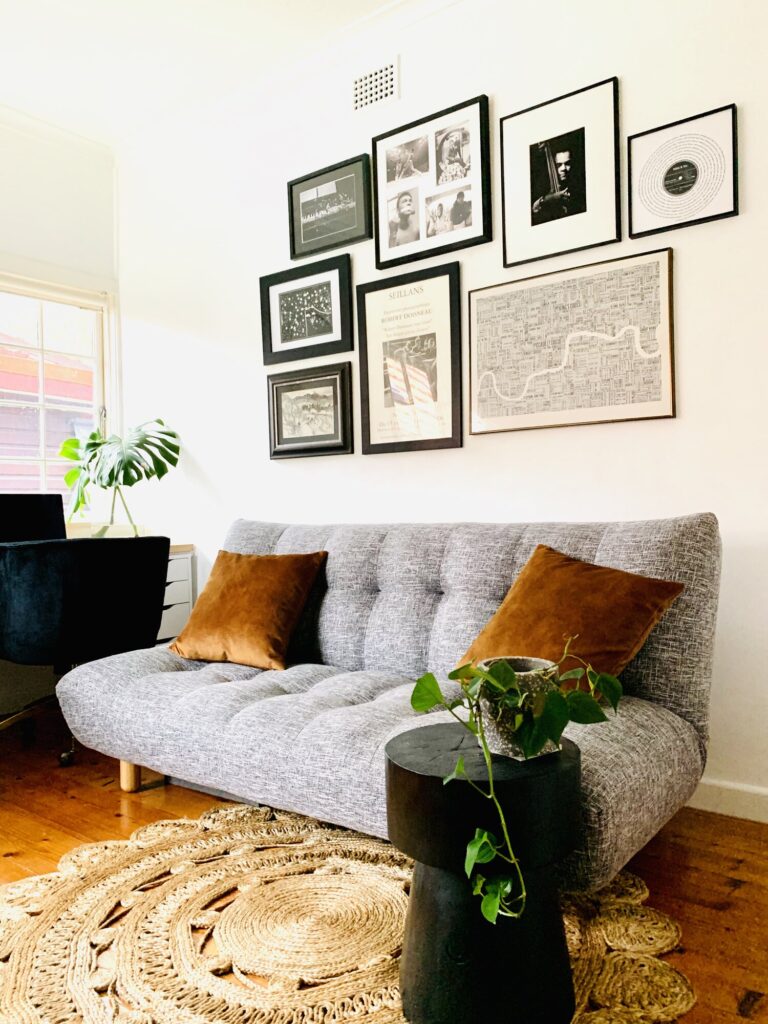Blog
From the latest interior design trends to timeless classics, we aim to inspire you with our expert interior designer tips, industry insights, and behind-the-scenes peeks into our projects.
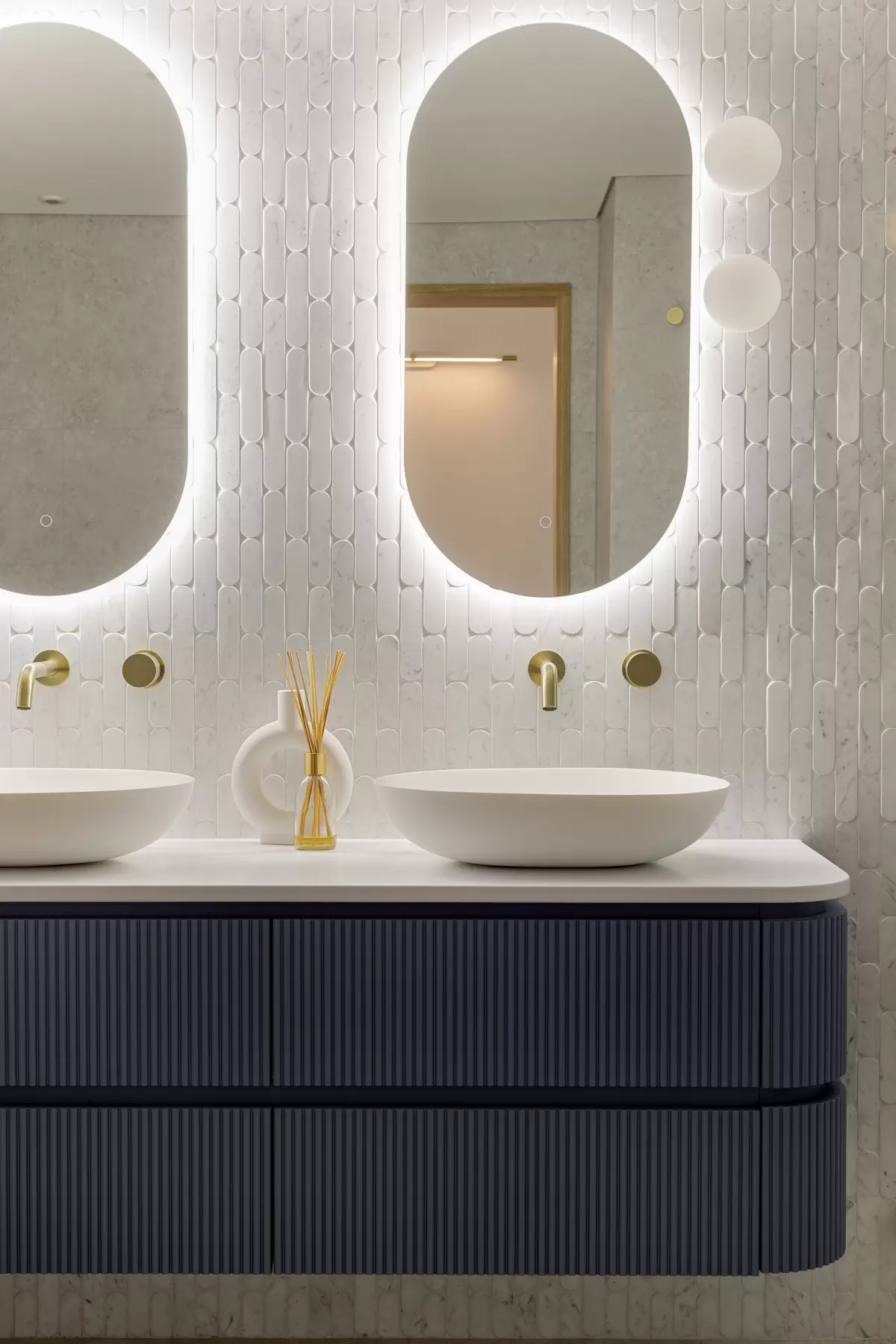
09 Nov
Choosing Tiles for Your Renovation: Tips from a Sydney Interior Designer
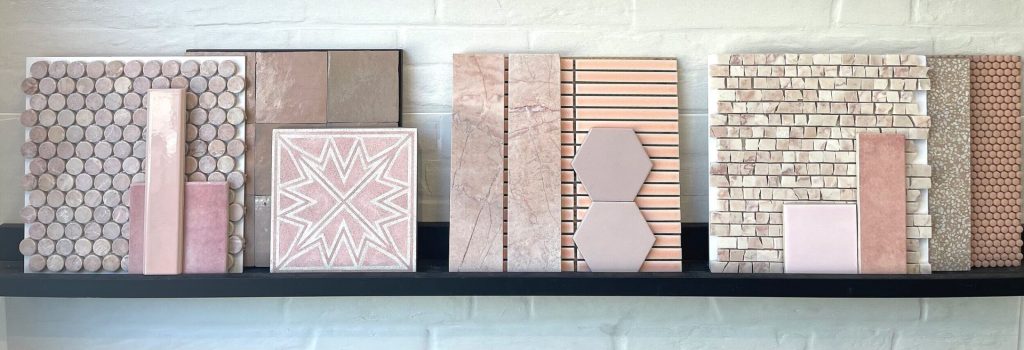
Planning a home renovation? If you’re in Sydney, you’re in the perfect place to explore some incredible tile options that blend style, durability, and functionality. As a Northern Beaches interior designer, I often see clients feeling overwhelmed by the sheer number of tile choices out there. But don’t worry—here, I’ll share practical advice to make the tile selection process enjoyable and, most importantly, stress-free.
Whether you’re updating a bathroom, kitchen, or outdoor area, choosing tiles can make a significant difference in the overall look and feel of your space. Keep reading for key considerations and tips that will help guide you through this essential aspect of your renovation.
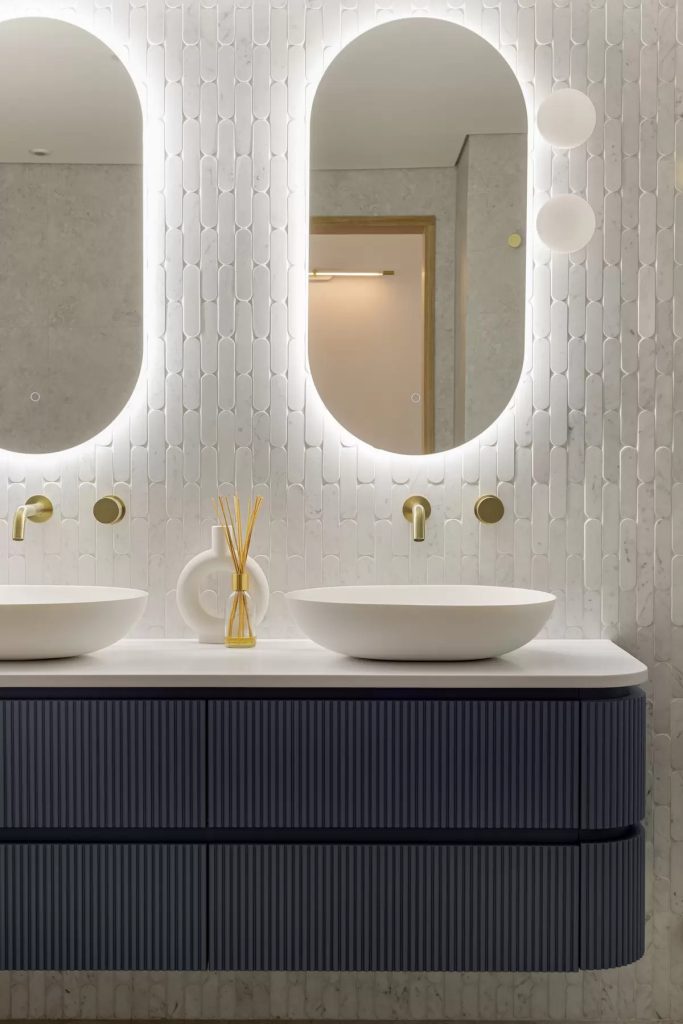
1. Start with the Room’s Purpose
Tiles come in a range of materials, styles, and durability levels. Each room has specific requirements, so the first question to ask yourself is: Where am I placing these tiles? This may seem simple, but narrowing down the purpose helps eliminate choices that might not be suitable.
Bathrooms: Bathrooms require moisture-resistant tiles. Porcelain and ceramic are popular choices here, as they’re water-resistant, easy to clean, and can withstand daily use.
Kitchens: For kitchen floors, consider tiles that can handle heavy foot traffic and the occasional spill. For splashbacks, let your creativity shine—mosaic, variable shade, gloss or matt tiles will add personality and can be cleaned easily.
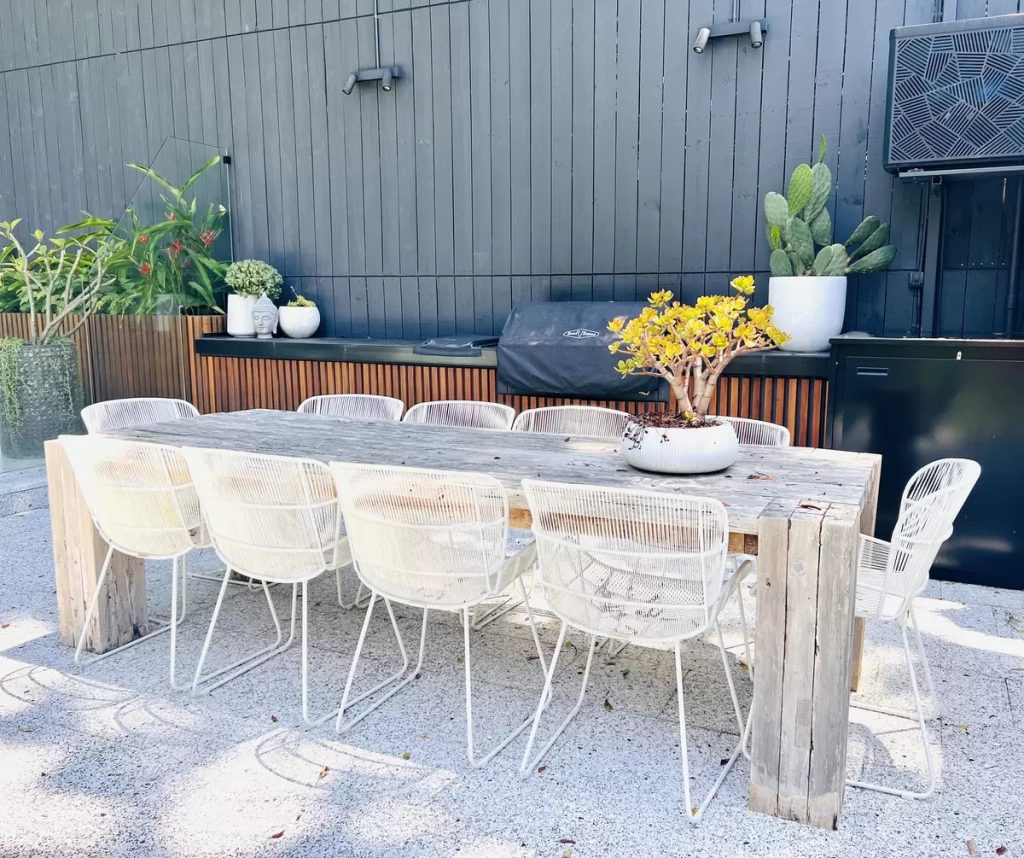
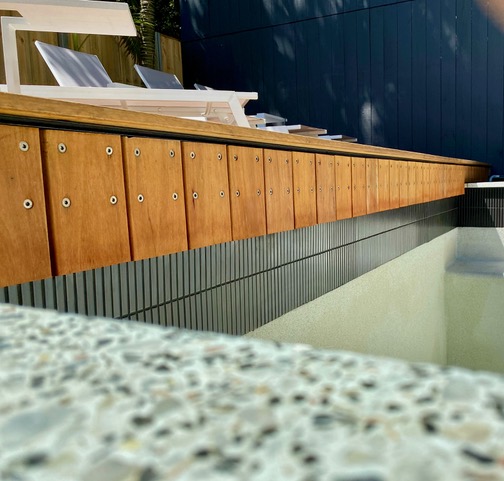

Outdoor Spaces: Choosing tiles for pool, patios or balconies? Make sure they’re weather-resistant and slip-proof. Stone and porcelain are excellent choices, offering both durability and style for Sydney’s mix of weather conditions.
2. Balance Aesthetic with Practicality
The style of tile you choose should reflect your personality and the mood you want to create, but functionality is key. A tile’s finish, texture, and importantly its slip rating (particularly in bathrooms and outdoor areas) can impact its practicality.
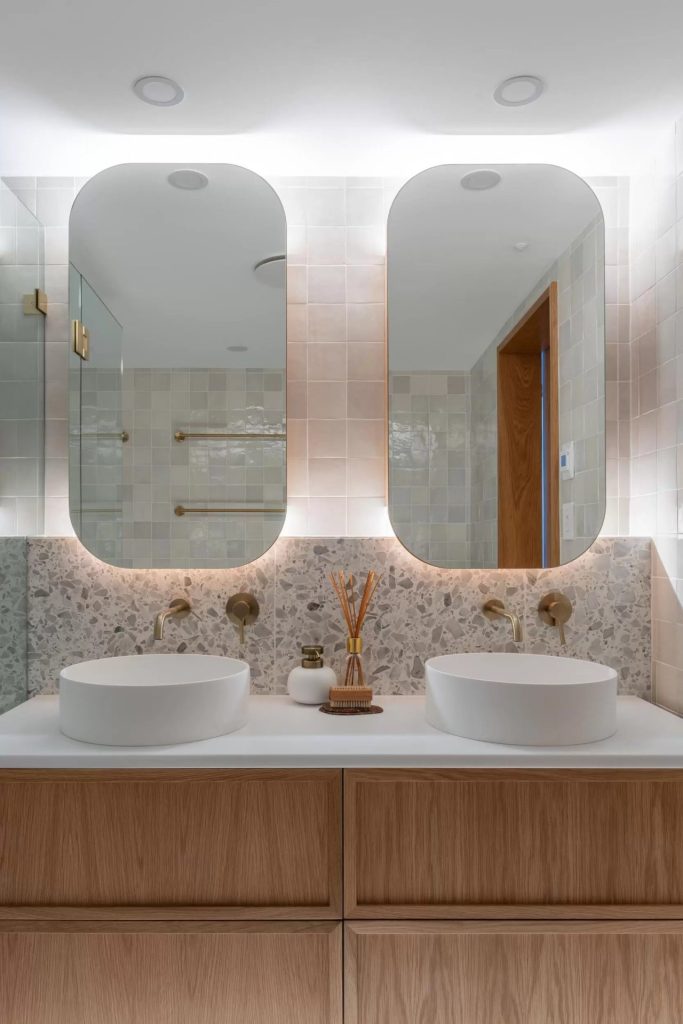
Glazed vs. Unglazed Tiles: Glazed tiles are highly resistant to moisture and stains, making them a good choice for splash-prone areas like kitchens and bathrooms. Unglazed tiles, such as natural stone, have a beautiful, rustic look but require sealing to stay stain-free.
Glossy vs. Matte Finish: Glossy tiles reflect light, which can make a small bathroom or kitchen feel larger. However, they show water marks and fingerprints more easily, so they require frequent cleaning. Matte tiles, on the other hand, hide smudges well and offer a softer, more contemporary look.
3. Consider the Size and Layout of Your Space
Tile size and layout can dramatically alter the feel of a room. Larger tiles make a small space feel bigger by reducing the number of grout lines, while smaller tiles are perfect for areas where intricate designs or patterns can add interest, like bathroom feature walls.
Large Format Tiles: These are popular for open-plan living spaces and bathrooms, as they give a seamless, modern look. They also mean less grout, which can be easier to clean.
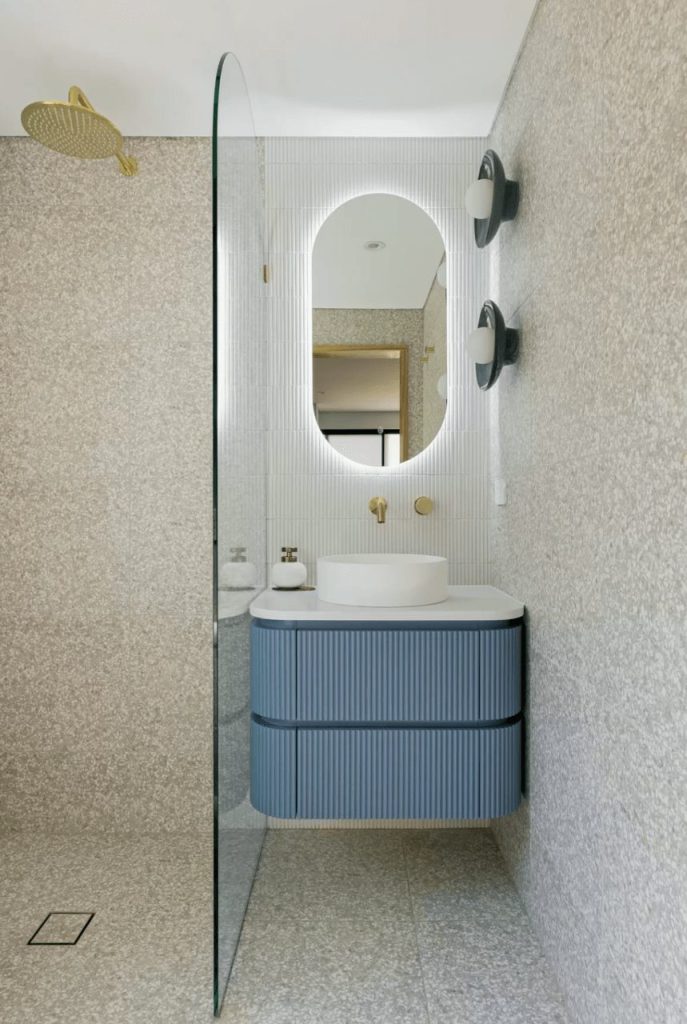

Subway Tiles: Classic subway tiles are perfect for a timeless look in kitchens or bathrooms, especially when installed in creative layouts like herringbone or vertical stacking.
Mosaics: While mosaics take more time to install, and certainly have more grout to clean, they create a wonderful sense of texture and visual interest, often with interesting plays on colour. Consider using them in shower niches, as a laundry splashback, or teamed in contrast with large format floor tiles with the larger tiles continued 1200mm high on a bathroom wall and the mosaic tile above it.
4. Pay Attention to Colour and Pattern
The colour of your tiles will set the tone for your entire room, so take your time with this decision. Neutral colours—whites, greys, beiges—are popular in Sydney homes as they provide a versatile base. But don’t shy away from using bold colours or patterns if you want to make a statement.
Neutral Tones: If you’re renovating for resale, neutral tones are a safe choice as they appeal to a broad range of tastes. They also create a calm, cohesive look. But don’t be tempted to go for the cheapest most basic grey or white tile as this will cheapen the look of your space and stand in the way of achieving a premium sale price. Neutral doesn’t have to be boring!

Statement Patterns: Patterned tiles are perfect for feature walls or floors, especially in a bathroom or entryway. Just be cautious with patterns—too many can overwhelm the space, so use them sparingly and ensure the colours are complemented with the rest of the space to achieve a sense of cohesion.
Colour Psychology: Remember, colour can impact mood. Blues and greens are calming and work well in bathrooms, while earthy tones can create a cosy atmosphere in kitchens. When designing a space consider the 60 – 30 – 10 rule of colour, with the majority of the space in one colour, 30% in a secondary shade and 10% in an accent colour through the use of accessories or small design features.
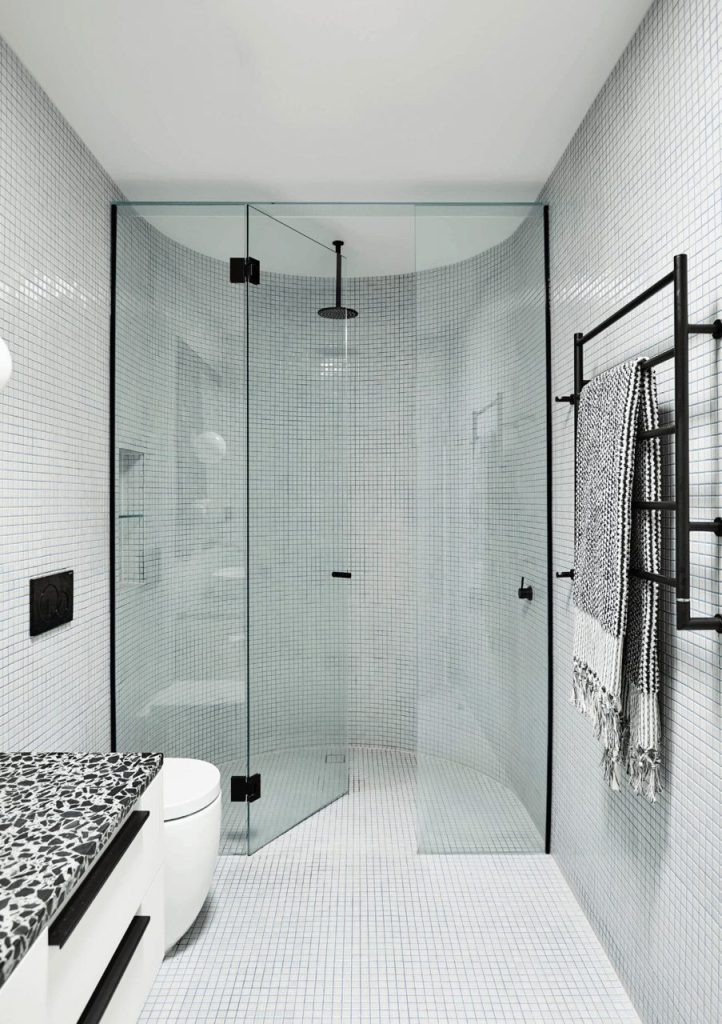
Image from Studio Doherty
5. Think About Grout
Grout might seem like an afterthought, but it’s an important part of your tile choice. The colour and thickness of grout lines impact both the look and the maintenance of your tiled areas. A good rule of thumb is a grout width of around 3mm for pressed edge floor tiles and no less than 1.5mm for wall tiles. Above all, be sure to select a quality product to ensure longevity.
Contrasting Grout: A darker grout against light tiles, or vice versa, can make a beautiful design statement and bring another element of colour into the design. Don’t be afraid to get creative and have some fun with it!
Matching Grout: Using grout in a similar shade to your tiles creates a seamless effect, making the space look larger. When choosing grout for dark floor tiles, find the darkest hues in the tile and choose a grout colour to match.
6. Don’t Forget About Maintenance
Different tile materials require different levels of maintenance. Stone tiles, for instance, need sealing to prevent stains, while porcelain tiles are low-maintenance and simply need regular cleaning.
Porcelain and Ceramic: These are some of the easiest tiles to maintain. They’re water-resistant, stain-resistant, and only need a quick mop or wipe down.
Natural Stone: Natural stone tiles like marble or travertine are beautiful but need extra care. Regular sealing is required to prevent stains, and it’s best to avoid using harsh chemicals.
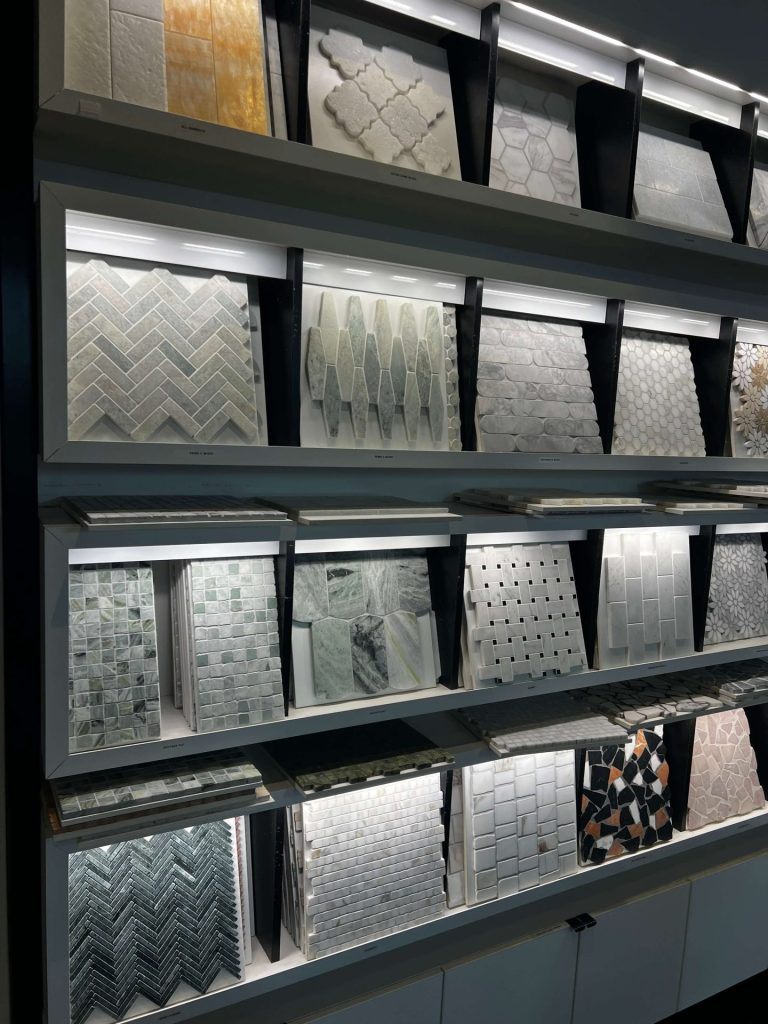
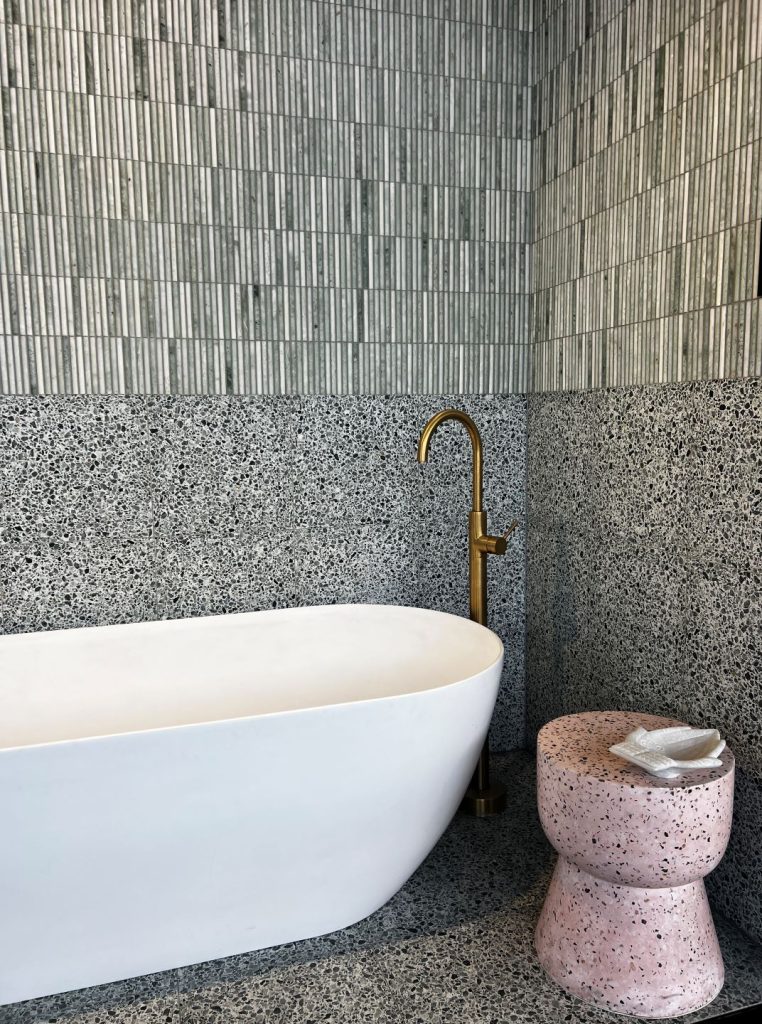
7. Set Your Budget
The cost of tiles can vary widely, and it’s important to choose tiles that meet both your design goals and your budget. Large format tiles or custom designs might be pricier, but you can often find budget-friendly options that offer a similar look. For smaller areas like powder rooms and splashbacks, you can afford to splash out a bit!
Quality Matters: For high-traffic areas, it’s worth investing in good-quality tiles that can stand up to daily wear and tear.
Sample Before You Buy: Always request a few samples before making a final decision. Tiles can look very different in person compared to online photos.
Final Thoughts
Choosing tiles for your renovation can feel overwhelming, but with the right approach, you can find the perfect balance of style, function, and durability. I’ve seen how thoughtful tile choices can elevate a space and make it feel truly unique. Keep these tips in mind, and you’ll be well on your way to creating a beautiful, practical space you’ll love for years to come.
If you’re looking for more renovation help, don’t hesitate to reach out for personalised advice here — happy tiling!
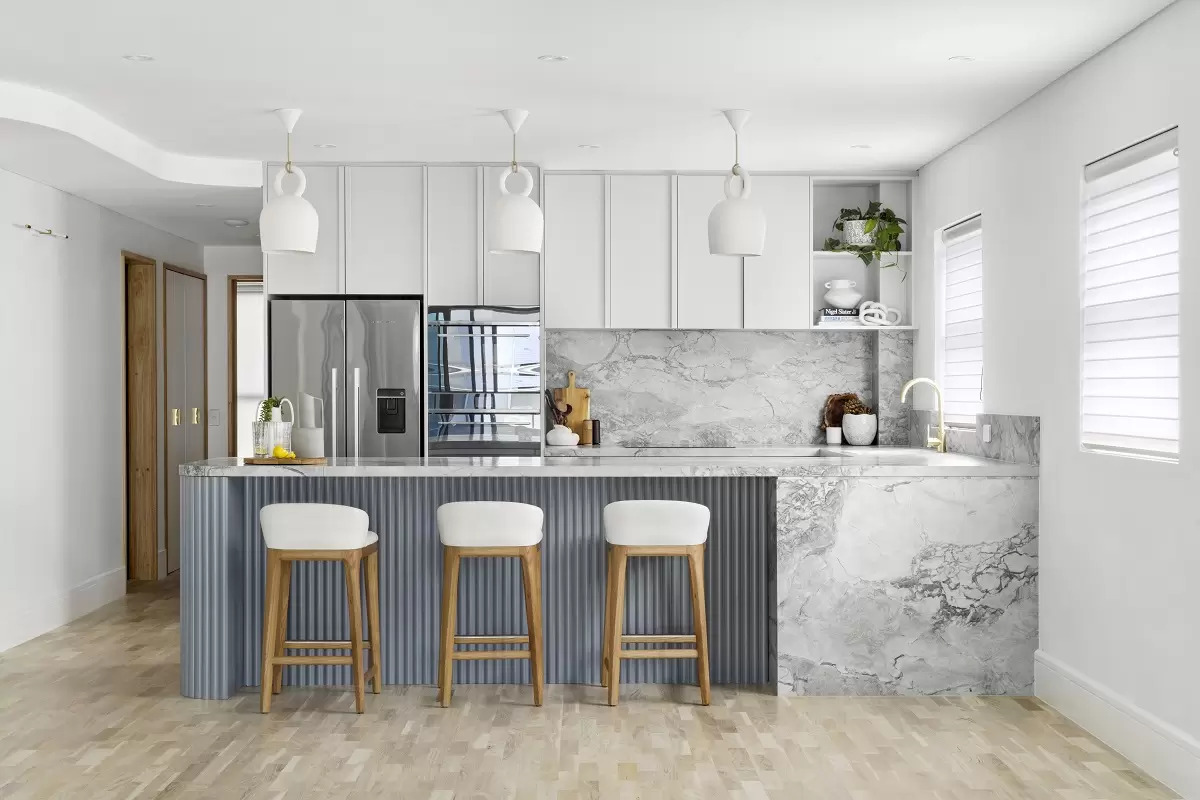
26 Oct
Why You Should Hire a Kitchen Designer for Your Northern Beaches Kitchen Design
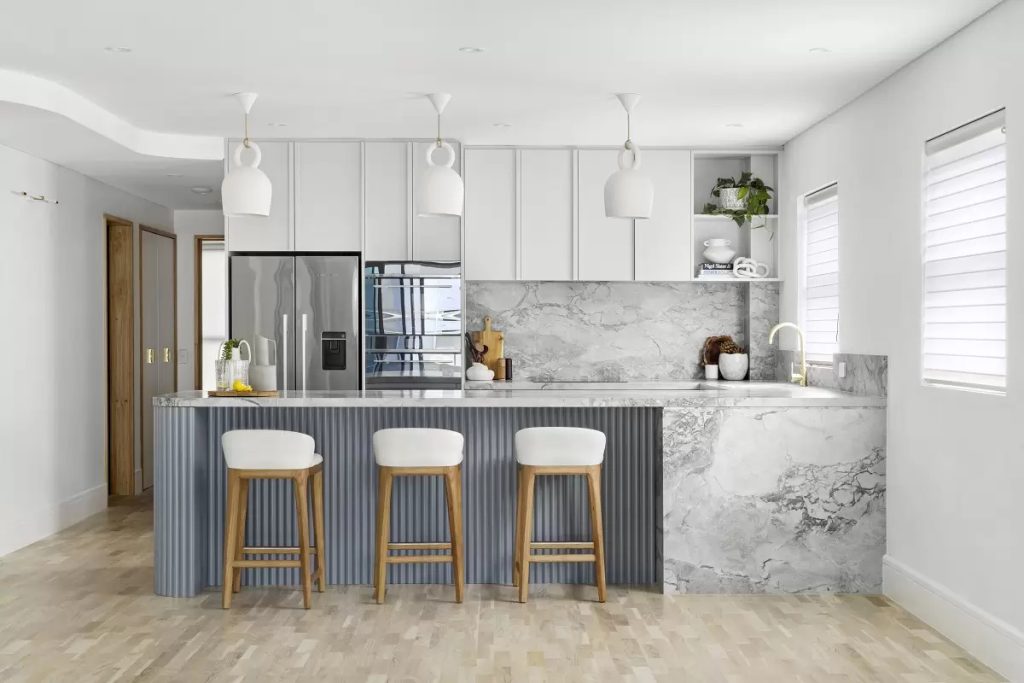
The kitchen is often considered the heart of the home—a place where family and friends gather, meals are created, and memories are made. Given its importance, renovating a kitchen can be one of the most rewarding investments you make in your home. However, it can also be one of the most complex and overwhelming projects, with decisions to be made about layout, materials, appliances, and finishes. Not to mention the huge cost outlay, so making mistakes in this part of your house can either mean living with something that doesn’t function correctly or spending big to fix the problem.
That’s where we come in! A professional kitchen designer can make all the difference to your Northern Beaches kitchen renovation project.
Here are several compelling reasons to consider hiring a kitchen designer:
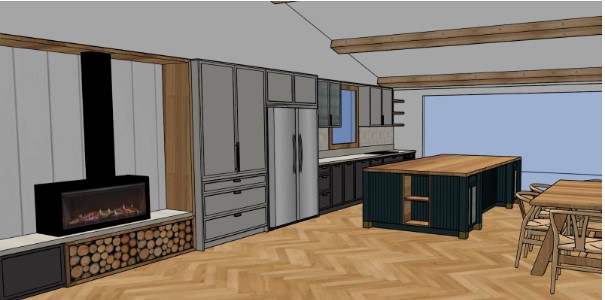

Kitchen designers are specialists in their field. They understand the nuances of kitchen design that go beyond just aesthetics. With a thorough knowledge of space planning, ergonomics, and the latest design trends, they can create a kitchen that’s not only beautiful but functional too. From optimising cabinet storage to creating work triangles that make food prep easier, their expertise ensures you get the most out of your space.
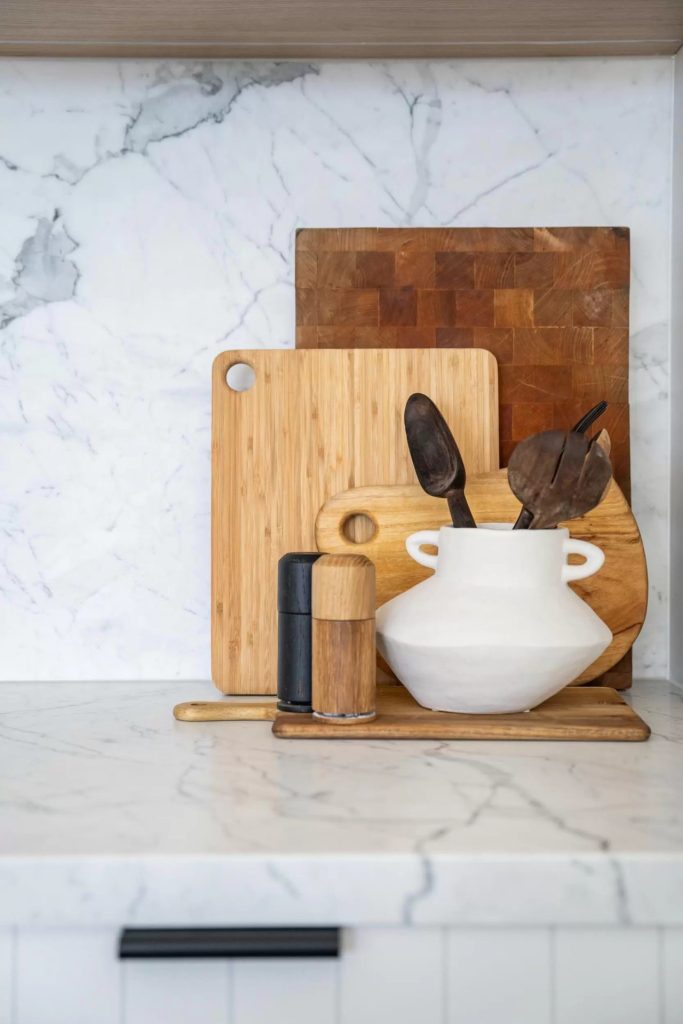
A professional kitchen designer will take the time to understand how you use your kitchen. They will create a space that fits your lifestyle, ensuring the design serves your specific needs.
Whether it’s integrating a large island for gatherings or selecting the perfect drawer system for easy access to cooking tools, they customise every detail to work for you. This personalised approach not only enhances your day-to-day living but also adds value to your home.
Renovating a kitchen is a complex process that involves countless decisions. From the layout and material selections to lighting, hardware, and appliances, it’s easy to get overwhelmed. A kitchen designer takes on the heavy lifting, streamlining the decision-making process and coordinating the project from start to finish. This reduces the stress of the renovation and ensures that your kitchen comes together seamlessly.
Hiring a designer also helps you avoid costly mistakes. Whether it’s selecting incompatible materials or misjudging space requirements, a designer has the foresight to catch potential issues early and prevent setbacks down the road.
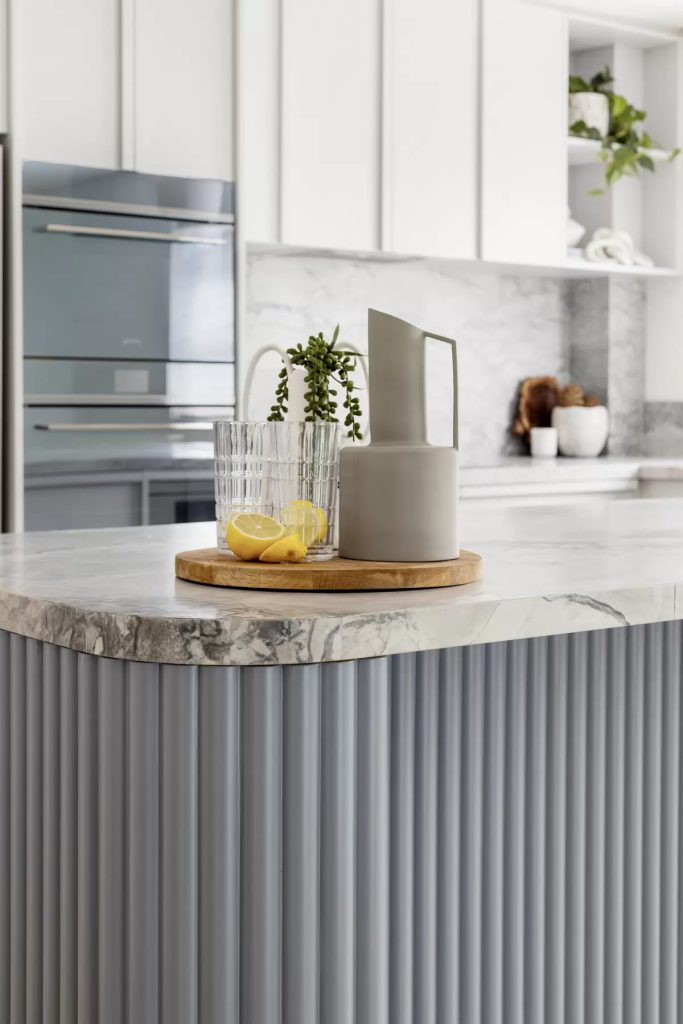
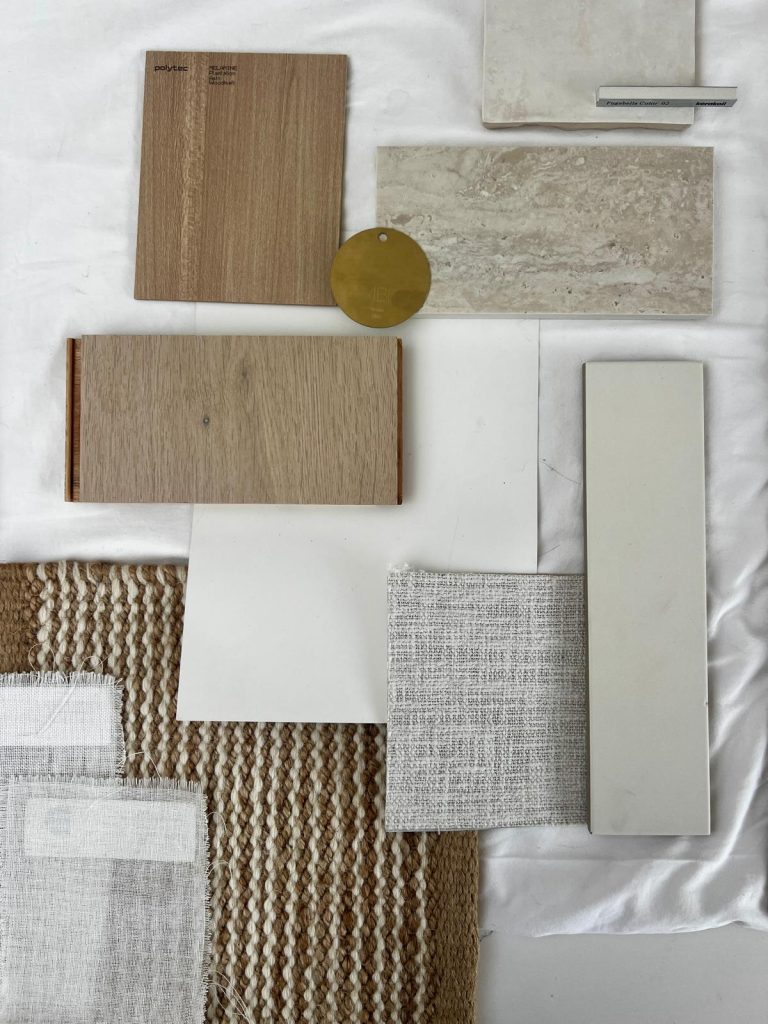
One of the perks of working with a professional kitchen designer is gaining access to exclusive resources. Designers often have connections with suppliers and manufacturers, giving you access to high-quality materials that aren’t available at standard retail stores. They also have experience with a range of products and can recommend materials that fit both your budget and style while ensuring durability and performance.
Additionally, designers can source custom pieces—whether it’s a unique backsplash or bespoke cabinetry—that add a one-of-a-kind touch to your kitchen. These elements can truly elevate the look and feel of the space, making it uniquely yours.

A well-designed kitchen is one of the top factors that can increase the value of your home. By working with a professional designer, you’re ensuring that your renovation meets the latest trends and standards while also addressing the preferences of potential buyers. Even if you’re not planning to sell immediately, investing in a quality kitchen now means your home will stand out in a competitive market when the time comes.
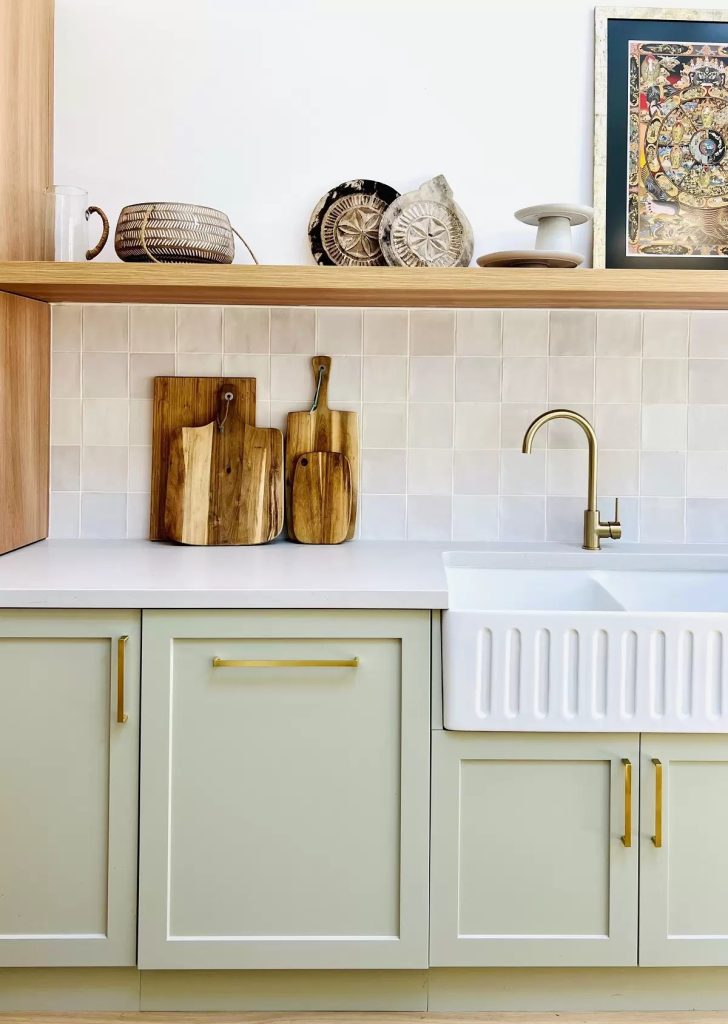
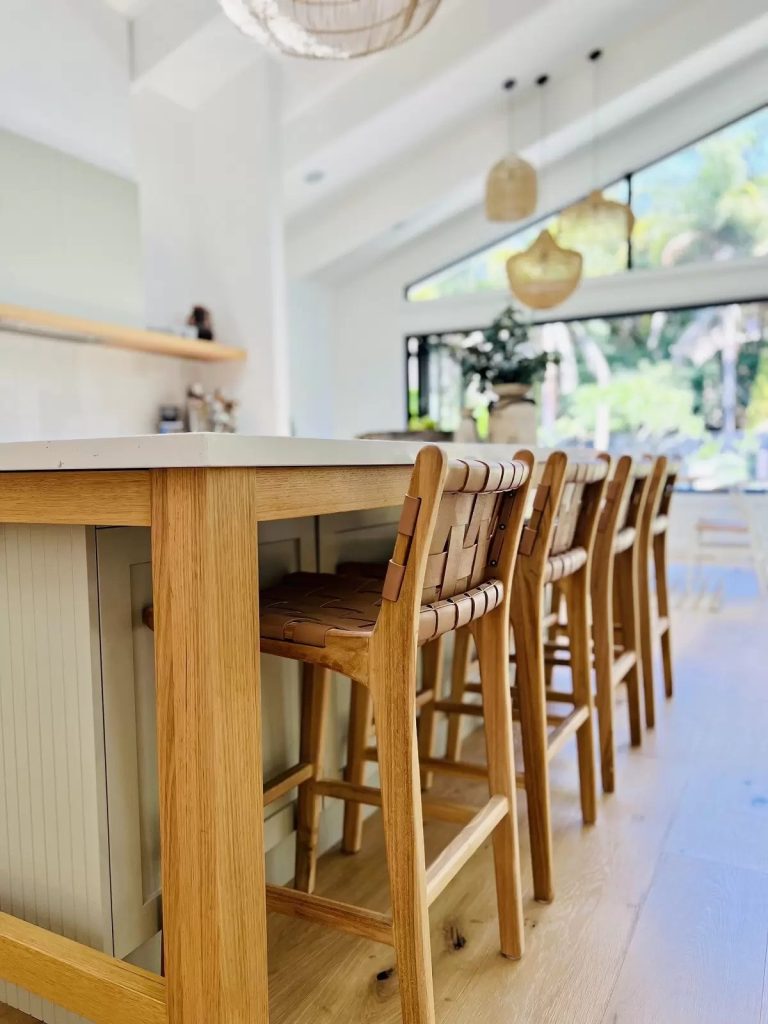
If sustainability is a priority for your renovation, a kitchen designer can guide you toward eco-friendly solutions. From energy-efficient appliances to sustainable materials, they can help reduce the environmental impact of your kitchen. Designers are often well-versed in green building practices and can introduce you to products that improve energy efficiency, indoor air quality, and waste reduction.
Whether you’re interested in using recycled materials, choosing non-toxic finishes, or installing energy-saving appliances, a designer will know the best options available on the market.
Perhaps the most important reason to hire a kitchen designer is their ability to bring your dream kitchen to life. While you may have an idea of what you want, turning that vision into reality requires expert design skills and careful planning. A kitchen designer can create detailed renderings and layout plans that allow you to visualise the finished space before construction even begins.
This level of planning ensures that every detail—down to the lighting, countertops, and even cabinet hardware—is considered. It also allows you to make changes during the design phase, rather than mid-renovation when adjustments become costly and time-consuming.
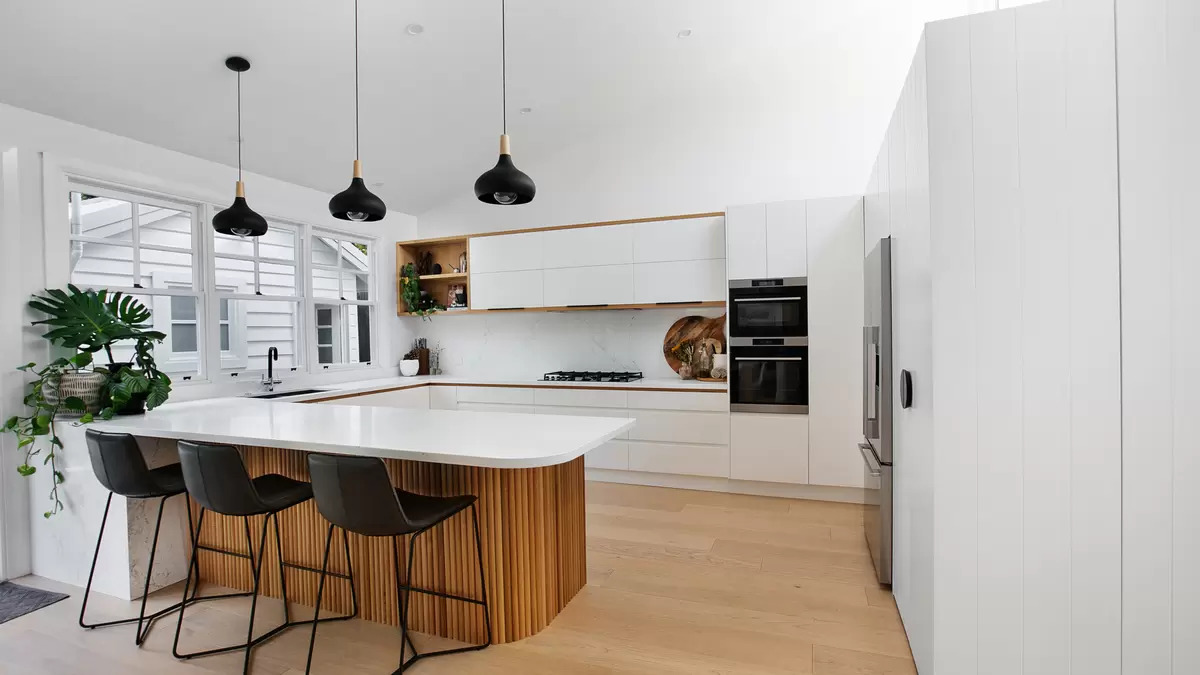
Renovating a kitchen is a significant investment, and hiring a kitchen designer can help you maximise the potential of your space while making the process as smooth and stress-free as possible. With their expertise in design, project management, and access to exclusive resources, they can transform your kitchen into a space that enhances both your lifestyle and the value of your home.
If you’re ready to embark on a kitchen renovation, consider bringing a professional designer on board to guide you every step of the way. You’ll end up with a space that’s not only functional and beautiful but one that you’ll enjoy for years to come.
If you would like some help with your forthcoming renovation or interiors project please feel free to reach out to us here – we’d love to help you!
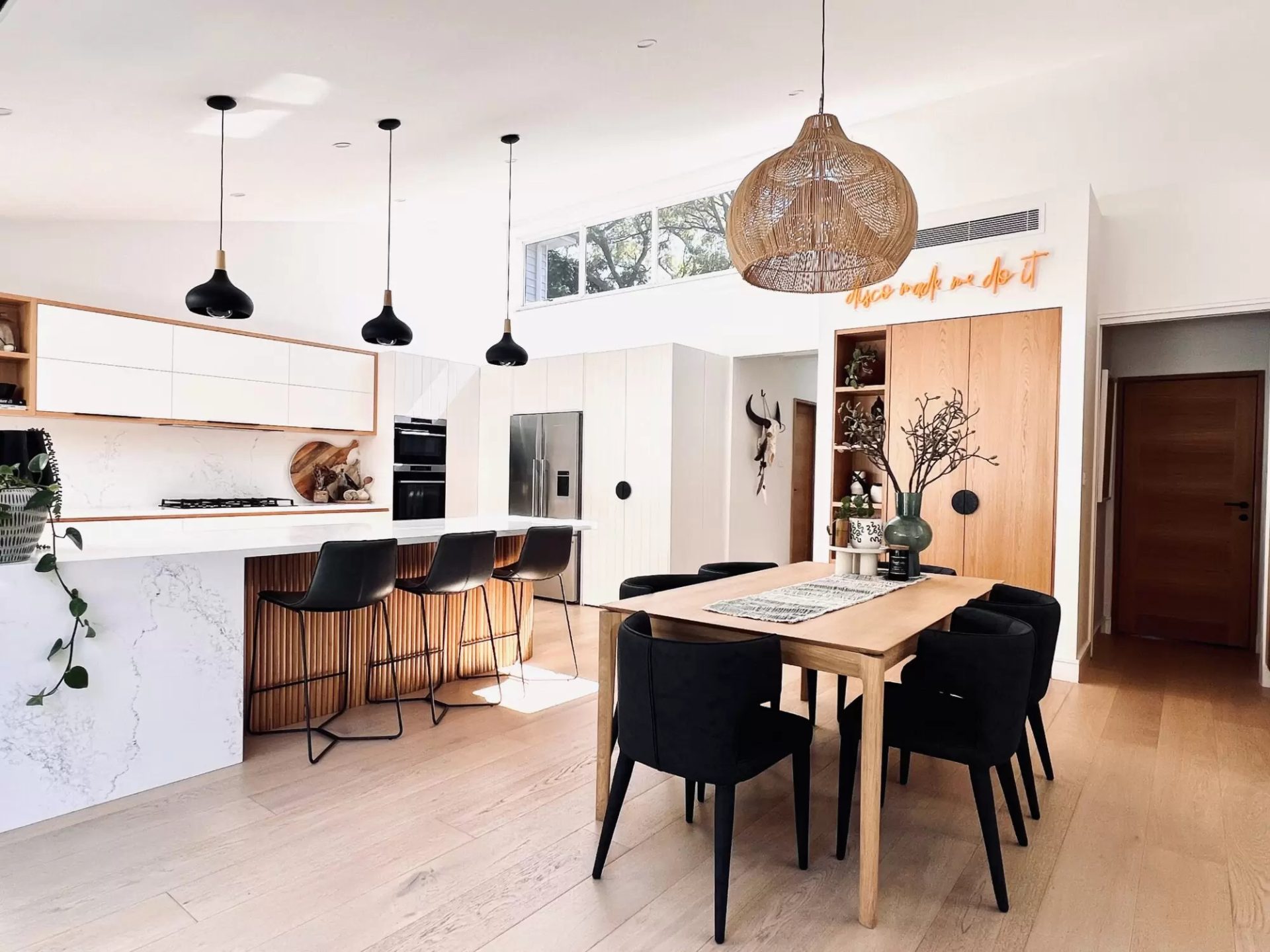
12 Oct
Renovating Your Home: A Step-by-Step Guide by a Northern Beaches Interior Designer
You know you want to renovate but where do you even start?!
Renovating your home is one of the most exciting yet daunting experiences. With endless possibilities and the promise of a transformed living space, it’s easy to get swept up in the vision. However, without proper planning, things can quickly become overwhelming and Sydney’s stunning Northern Beaches have some specific traits well worth considering. From balancing coastal conditions to blending laid-back charm with modern functionality, there’s a lot to consider. If you’re a homeowner wondering where to start with your renovation journey, this guide is for you!
1. Begin with Design and Planning
2. Decide on DIY or Professional Help
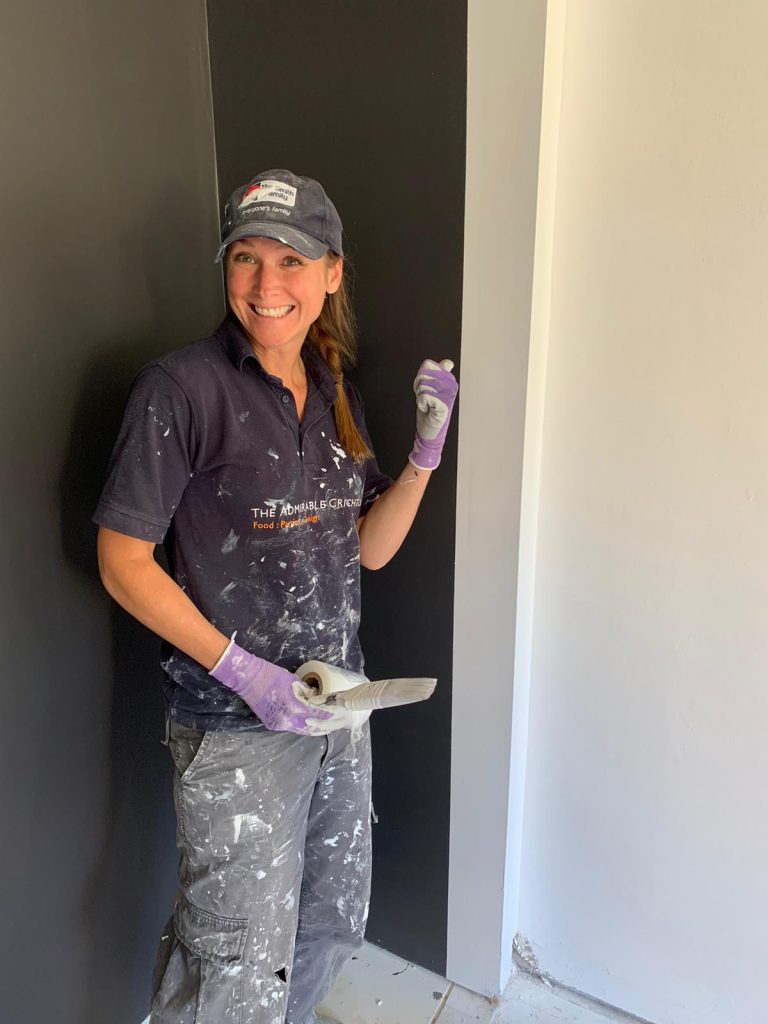
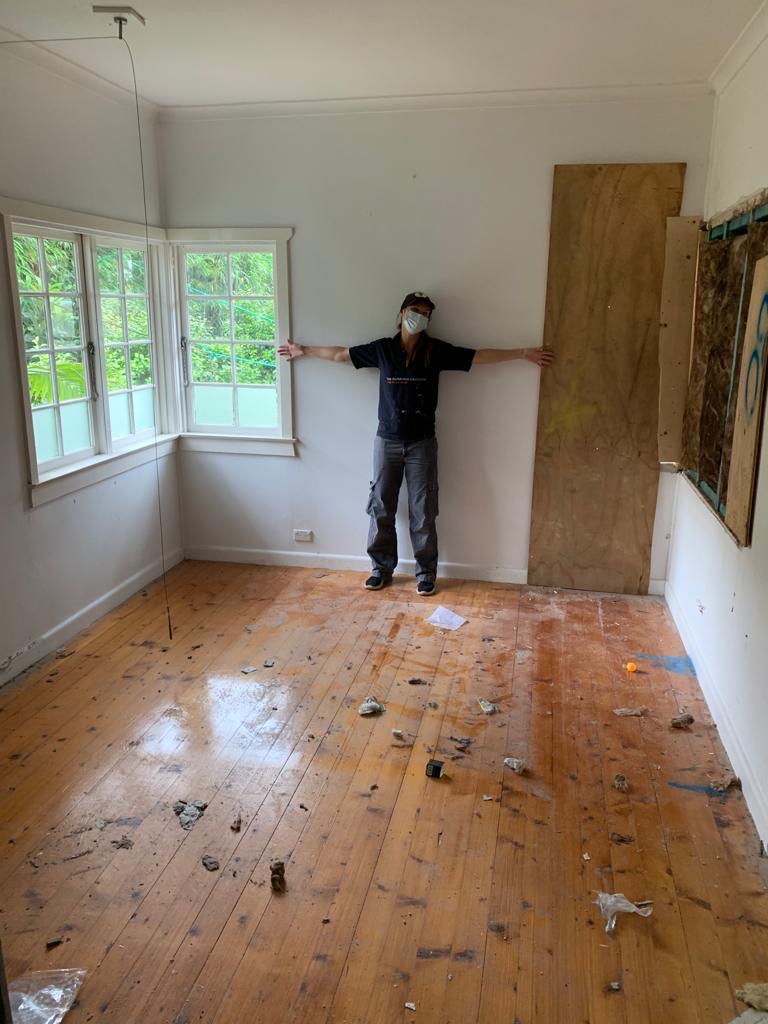
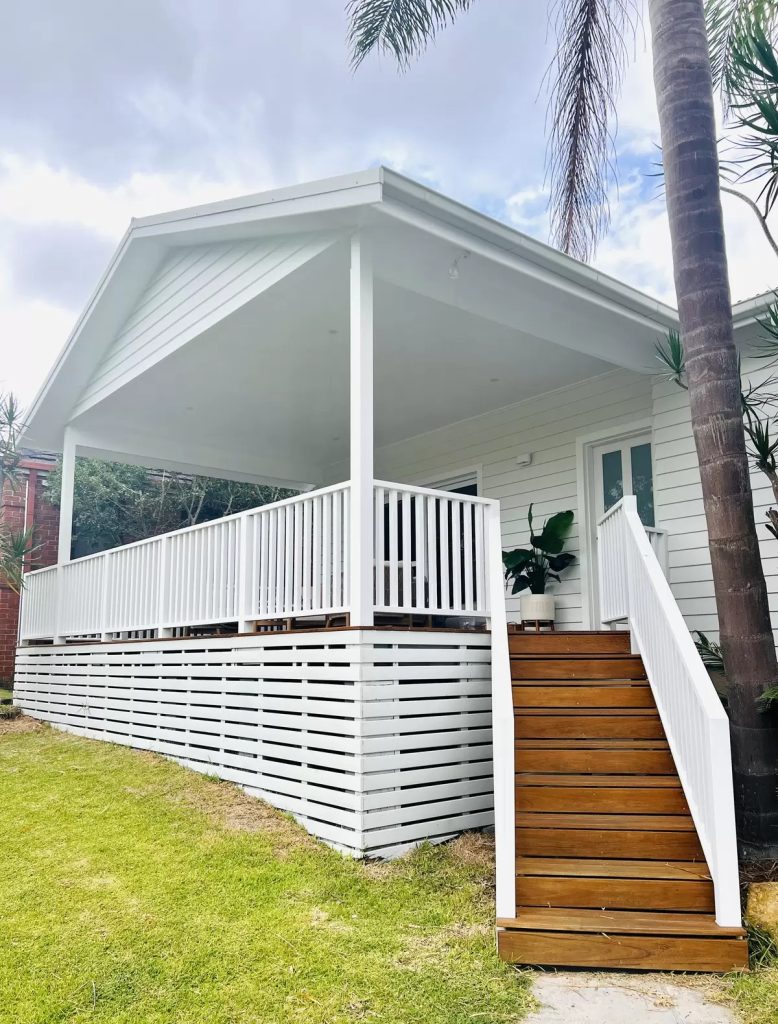
3. Secure Council Approval
Council regulations can vary, so it’s crucial to check with your local council before making any significant changes to your property. You may need approval if you’re:
Key tip – Allow plenty of time to acquire the necessary approvals… the wheels of council often grind slow!
4. Prepare Your Budget

Landscaping – for Northern Beaches homes, don’t forget to factor in landscaping and outdoor elements. Decks, pergolas, and outdoor kitchens are highly desirable in coastal areas, adding significant value to your property.
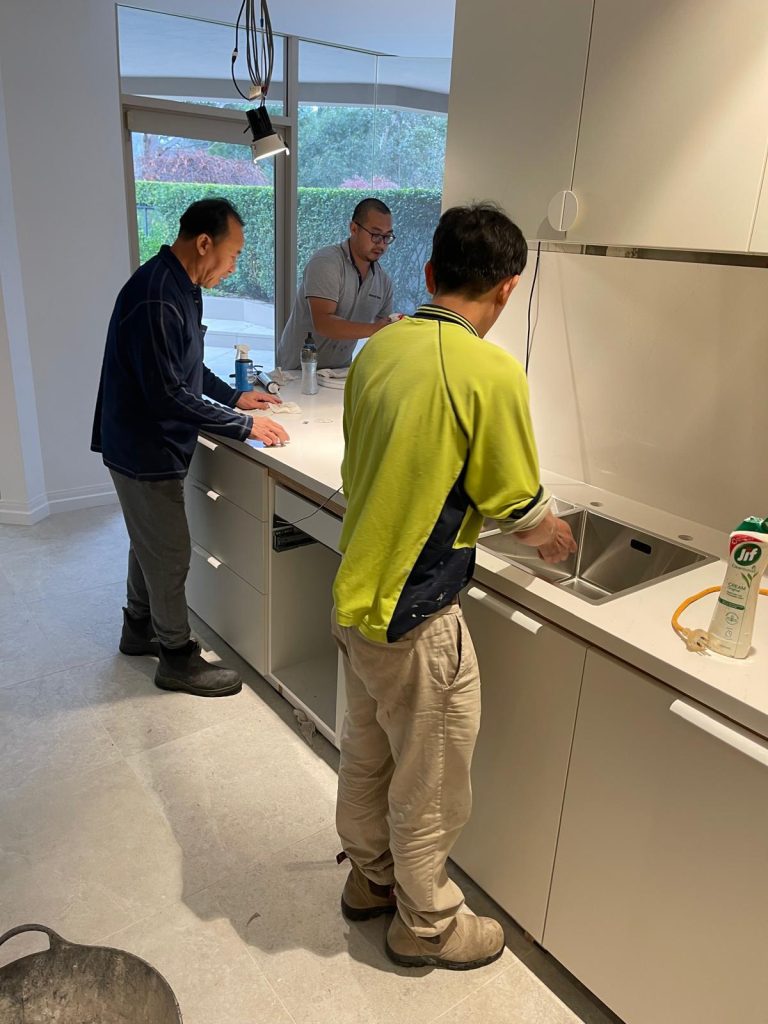
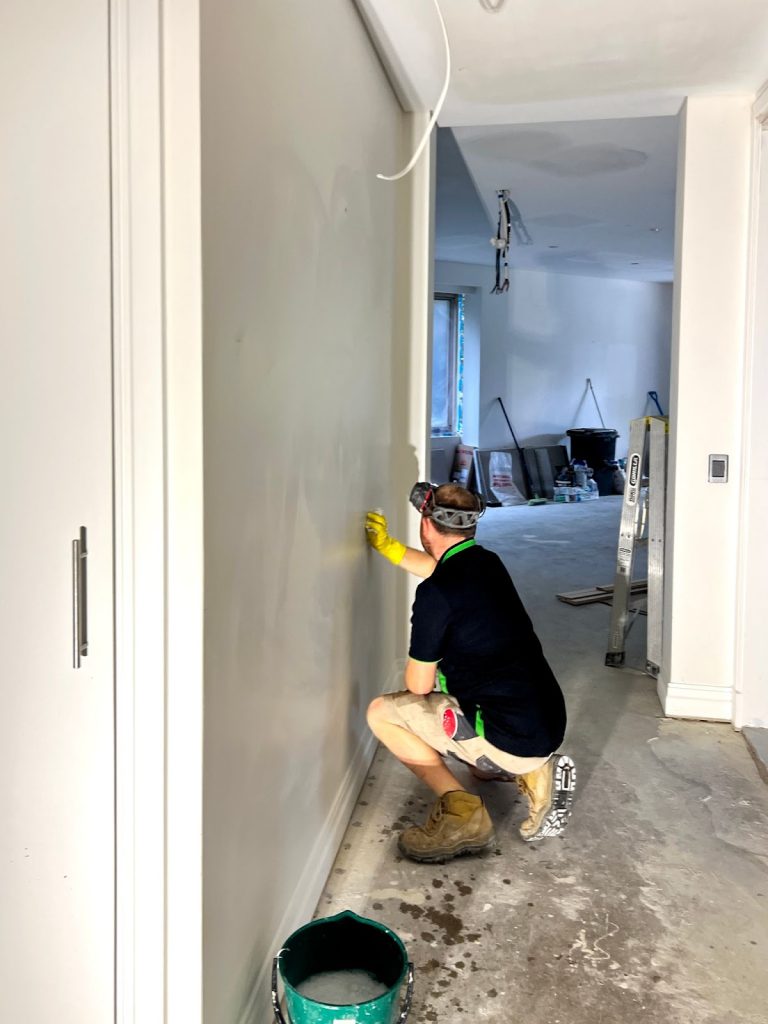
4. Follow the Right Sequence of Works
To avoid unnecessary headaches and rework, always follow the right order when tackling renovations. The general rule is to work from the top down:

6. Prepare for Unexpected Delays
Even with the best-laid plans, renovating is unpredictable. From hidden issues like asbestos to delayed material deliveries, there are always unexpected obstacles. Don’t rush the final stages. In fact, many professionals agree that the last 20% of a renovation takes the longest and can cost the most.
Key tip: Stick to your checklist and budget, but be ready for surprises. Flexibility is essential in ensuring a smooth renovation.
Renovating your home can be both a rewarding and challenging experience. By following this step-by-step guide, you’ll be able to create a beautiful, functional space that reflects the relaxed coastal lifestyle of the Northern Beaches while adding value to your property.
If you’re unsure where to start or need assistance managing the process, please feel free to reach out to us here – we’d love to help you! With expert knowledge of local conditions and regulations, your renovation journey will be a smooth one.

28 Sep
How to Choose the Perfect Sofa for Your Home
Choosing a sofa can feel like a big commitment, especially when it’s the centrepiece of your living room. It’s not just about comfort – your sofa should reflect your style and meet the practical needs of your home. Whether you’re looking for something timeless or trendy, here are a few key factors to consider when selecting the right sofa.
1. Frame Matters
Investing in a quality frame is crucial to the longevity of your sofa. Look for a solid hardwood frame, such as beech or oak, as these materials are strong and durable. Sofas with inferior frames might be cheaper upfront but will cost you more in the long run.
2. Manufacturer Guarantee
It’s always a good idea to check the manufacturer’s guarantee. The longer the period, the more confident they are in the product’s durability. Aim for at least a 10-year guarantee on the frame.
3. Cushion Fill: Feather, Foam, or Fibre?
Comfort is everything, and cushion fill plays a huge role in that. Feather cushions are soft but can lose shape over time. Foam provides more structure but can be a little firm. For the best of both worlds, I recommend opting for foam cushions wrapped in a feather layer. This gives you the softness of feather with the support and longevity of foam.

4. Cushion Channels
My top tip and a detail often overlooked is the inclusion of channels in the cushions. These are small tubes or pockets sewn into the fabric to contain the feathers, preventing them from bunching up in one area. This simple feature can keep your sofa looking plush and even.
5. Fabric Choices
The fabric you choose will set the tone for your sofa’s style. Most sofas come with a limited range of fabric options, but some manufacturers offer full customisation. Consider your lifestyle when choosing fabric – if you have kids or pets, go for a durable, easy-to-clean material. Look for built in scotch guarding properties like Zepel’s FibreGuard. If your sofa is more of a showpiece than a daily-use item, you can splurge on something a little more luxurious.
6. Colour Selection
Choosing the right colour can make or break your sofa’s presence in your space. Remember, dogs and white sofas don’t mix well! However, going too dark might overwhelm a small or poorly lit room. Find a balance that works with your existing décor and lighting conditions.

7. Cleaning & Maintenance
Life happens, and spills are inevitable. Consider whether you need a sofa with removable, washable covers or if a simple spot-clean fabric will suffice. Either way, it’s always a good idea to scotchgard your sofa as soon as it arrives to protect it from accidental stains.
8. Get the Size Right
It sounds simple, but measuring your space – and measuring again – is critical. Don’t forget to consider access points such as doorways, hallways, and staircases to make sure your sofa can actually get into your home!
9. Lead Time Expectations
Most custom-made sofas have a lead time of 16-20 weeks. If you’re in a rush to furnish your space, consider opting for a local manufacturer. For example, @craftedfurnituresydney offers beautiful custom options and, because it’s made in Sydney, you can expect your new sofa in just 8 weeks!
Conclusion
Choosing a sofa is a big decision, but with these tips in mind, you’ll be well-equipped to make the best choice for your space. Whether you’re designing your dream living room or updating your current space, remember to think about comfort, practicality, and your personal style.
If you would like some help with any styling or interior design projects please feel free to reach out to us here – we’d love to help you!
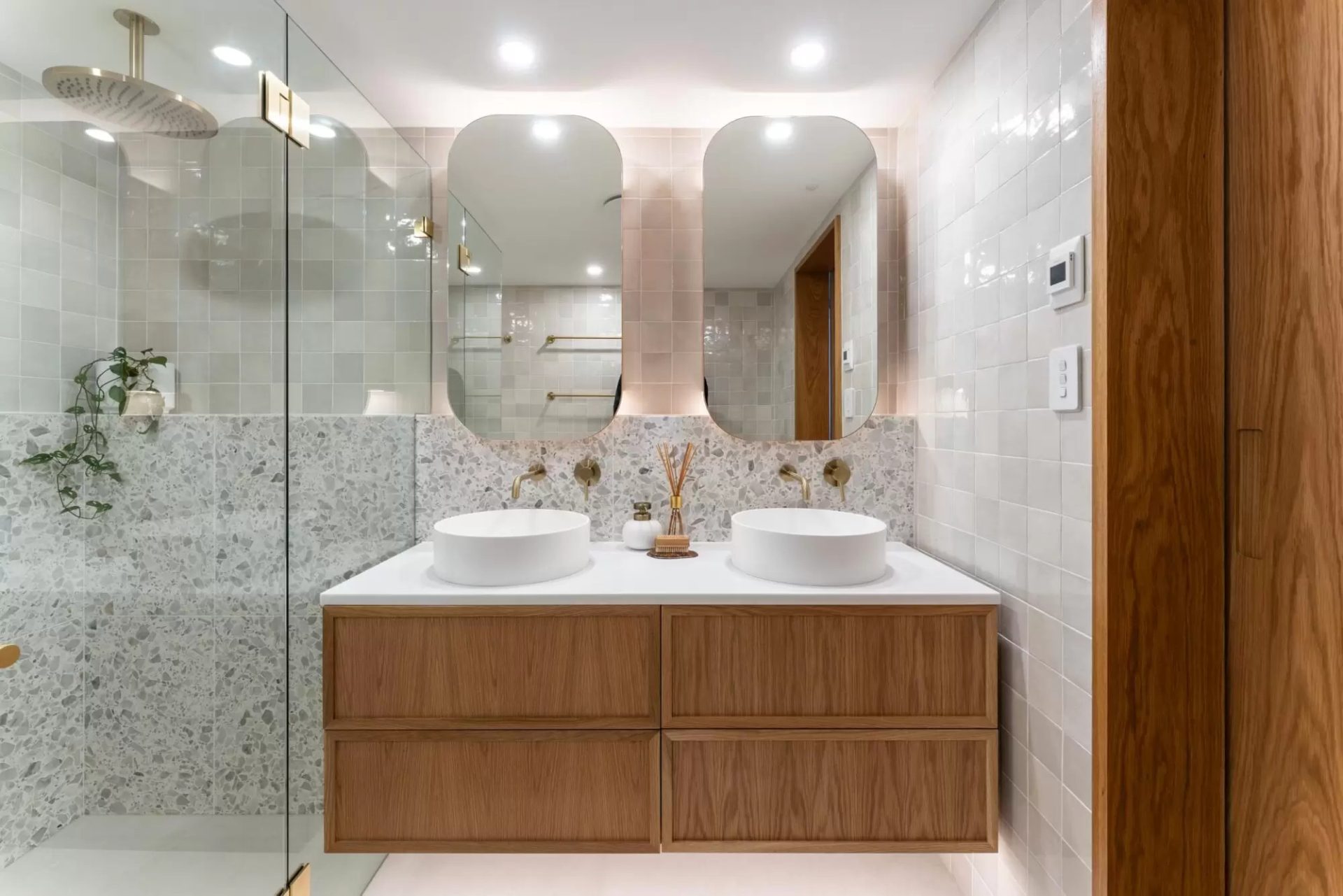
12 Sep
Transform Your Space: A Guide to Bathroom Renovations in Sydney
Renovating your bathroom can be one of the most rewarding home improvement projects. Not only does it enhance the overall aesthetic of your home, but it also increases the property’s value. Whether you’re looking to update an outdated space, improve functionality, or add a touch of luxury, a well-planned bathroom renovation can transform your home into a modern sanctuary. In this guide, we’ll explore essential design tips, standard measurements, and considerations to ensure your bathroom renovation is a success.
1. Planning Your Bathroom Renovation
Before diving into the renovation process, careful planning is crucial. Consider the following steps to ensure a smooth and efficient renovation:
2. Standard Measurements for Bathroom Renovation
Understanding the standard measurements for bathroom fixtures is crucial to creating a functional and comfortable space. Here’s a breakdown of the essential dimensions:
3. Design Tips for a Stunning Bathroom Renovation
Now that you have the basics of bathroom layout and measurements, let’s dive into some design tips that will elevate your bathroom renovation in North Sydney.
A successful bathroom renovation often requires a team of skilled professionals, especially for complex tasks such as plumbing, electrical work, and tiling. Hiring the expertise of an interior designer will make sure your money is well spent on creating a beautiful space with an effective and functional layout. When choosing contractors in Sydney, consider the following:
A well-executed bathroom renovation can transform your Sydney home, making it more functional, beautiful, and valuable. By understanding standard measurements, incorporating smart design tips, and hiring the right professionals, you can create a space that meets your needs and reflects your personal style. Whether you’re updating a small bathroom or creating a luxurious retreat, careful planning and attention to detail will ensure your renovation is a success. Happy renovating!
If you would like some help with your forthcoming renovation or interiors project please feel free to reach out to us here – we’d love to help you!
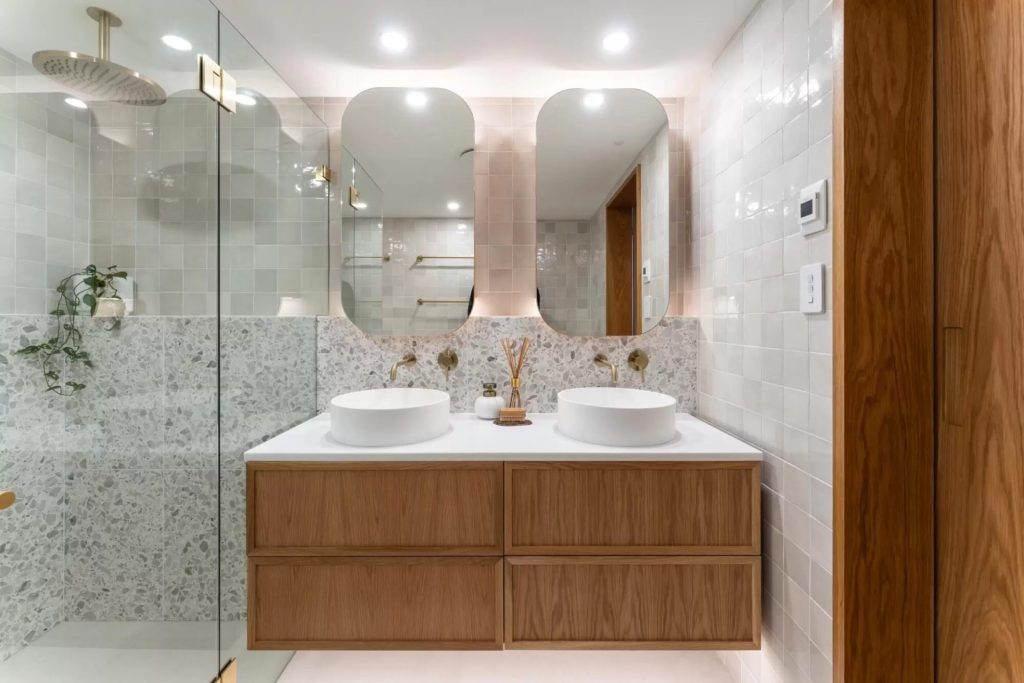

30 Aug
Why a Thoughtful Lighting and Electrical Plan is Key to Your Renovation Success
When it comes to renovating, there’s one aspect that’s often underestimated but can make all the difference: a well-thought-out lighting and electrical plan. Have you ever gone to plug something in and realised there is no convenient power point? As a Sydney interior designer, I’ve seen firsthand how a proper lighting and electrical plan can make a space easy to use and a joy to live in. It’s not just about flipping a switch; it’s about creating an atmosphere, highlighting the best features of your home, and ensuring functionality for your daily life.

So, why is a lighting and electrical plan so important in making your renovation a ‘shining’ success?
Lighting Design: More Than Just Brightness – Lighting design is an art form in itself. It’s about finding the perfect balance between natural and artificial light, task and ambient lighting, and the overall mood you want to create in each room. Imagine walking into a beautifully renovated kitchen with the perfect pendant lighting hanging over the island. The kitchen pendant lighting doesn’t just illuminate the space; it adds character, warmth, and style. Without a proper lighting plan, you can easily miss out on subtle yet impactful details.

On the Northern Beaches, where we love to blend indoor and outdoor living, lighting design becomes even more crucial. Natural light is abundant, but it’s the strategic placement of artificial lighting that can make your home feel cosy and inviting as the sun sets. Whether you’re after a minimalist look with sleek, modern fixtures or something more rustic using natural materials, having a clear plan in place ensures that every corner of your home is well-lit and welcoming.

The Role of Electrical Planning in Renovations – Hand in hand with lighting design is electrical planning. This is the backbone of your renovation project, and getting it right from the start can save you a lot of headaches down the line. Electrical planning involves more than just deciding where to place power outlets. It’s about understanding how you’ll use each space, what appliances or gadgets will need power, and how to future-proof your home for any technology upgrades.
For instance, in a kitchen renovation, you’ll need to consider not just the placement of kitchen pendant lighting but also where your appliances will go, where you’ll need extra outlets, and how the lighting will work with your overall kitchen design. Proper electrical planning ensures that your lighting is functional and that you have enough power points in all the right places. It also helps avoid the nightmare of having to ruin freshly painted walls because you forgot to include an outlet for that new appliance you just bought.
Here are a few things to consider in different rooms.
Kitchens: The heart of the home – The kitchen is often considered the heart of the home, and it’s a space where lighting and electrical design is particularly important.
Kitchen pendant lighting is a popular choice over the island or peninsula, and for a good reason. It not only provides focused light for tasks like cooking and meal prep but also adds some serious style to the space.
When choosing pendant lights for your kitchen, think about the size and scale of the fixtures in relation to your island or dining table. Too small, and they might get lost in the space; too large, and they could overwhelm the room. The right pendant lights should complement your kitchen’s overall design, providing both functionality and a visual focal point. Here are some quick win tips:

Busy Bathrooms – One of the most used but least thought about rooms in the home. Your bathroom needs to accommodate everything from shaving and makeup application to relaxing in the tub and the odd late night visit.
Like every space in the home, a layered plan provides for all these different circumstances:

Creating Ambiance with Lighting – The right lighting can completely transform the mood of a room. Whether it’s the soft glow of a wooden floor lamp in your reading nook or the dramatic effect of pendant lights in your dining area, lighting has the power to influence how we feel in a space.
When planning your lighting design and electrical plan, consider how each room will be used. By thinking about how you want each space to feel and function, you can create a lighting plan that enhances your home’s overall design.


The Importance of Joinery Lighting – Joinery lighting is a detail that can elevate the design and functionality of your cabinetry, shelving, and other built-in furniture. It not only adds an aesthetic appeal but also enhances the usability of these spaces.

Outdoor Lighting: Extending Your Living Space – Outdoor lighting plays a vital role in extending your living space beyond the four walls of your home, an absolute must here in our sunny Northern Beaches. Thoughtfully placed lighting can transform your garden, patio, or balcony into a magical retreat, perfect for entertaining or simply relaxing after a long day.

Consider:

Why Hire an Interior Designer for Your Lighting Plan? – Working with an experienced interior designer can make all the difference in your renovation project. We understand the unique lighting needs of homes in Sydney, from maximising natural light to selecting the perfect fixtures for our coastal lifestyle. Plus, we can help you navigate the technical aspects of electrical planning, ensuring that your home is not only beautiful but also functional and future-proof.
A thoughtful lighting and electrical plan is part of the crucial skeleton that your renovation is built around. It’s about more than just aesthetics; it’s about creating a home that is both practical and enjoyable to live in, day in and day out. So no matter the scope of your renovations, make sure you have a clear plan in place. Trust me, your future self will thank you!
If you would like some help with your forthcoming renovation or interiors project please feel free to reach out to us here – we’d love to help you!

16 Aug
Creating Your Dream Bedroom: Expert Styling Tips from your local Northern Beaches Interior Designer
Your bedroom is more than just a place to sleep; it’s your personal sanctuary and escape from the outside world. As a Sydney based interior designer, I’ve helped countless clients transform their bedrooms into dreamy, cosy retreats. Today, I want to share my top bedroom styling tips, to help you to create your own perfect space.

Start with a Soothing Colour Palette – Colour is one of the most powerful tools in an interior designer’s arsenal. It can change the mood of a room, make it feel larger or cosier, and it can have a great influence on your emotional wellbeing.
When it comes to your bedroom, selecting the right colour palette is essential. For the perfect tone of relaxation and comfort, choose soothing colours that resonate with you. Think soft blues, muted greys, or warm neutrals. These shades create a serene ambiance and serve as the perfect backdrop for the rest of your design elements. Remember, colour has a powerful impact on our emotions, so select hues that make you feel at ease. Consider not only the wall colour but also the colours of your bedding, curtains, and decor. These elements should work together to create a harmonious and inviting space. Don’t be afraid to experiment with different shades and combinations until you find the one that resonates with you the most.
Layer Up with Textures – Texture is a secret weapon in creating a cosy and inviting bedroom. It adds depth and visual interest to the space. The key to successfully incorporating texture is balance. Too much texture can make the room feel cluttered, while too little can make it feel cold and sterile.
Bedding: Experiment with different types of bedding. Mix and match linen sheets with a cosy, textured doona cover. Layer your bed with various pillows and throws in different materials. The interplay of textures not only feels luxurious but also visually enhances the room. A knitted throw or a velvet cushion can turn an ordinary bed into a sumptuous haven.
Rugs: A well-chosen rug can define your bedroom’s style and add warmth. Opt for a soft, plush rug beside your bed for that luxurious feeling underfoot. Alternatively, a natural fibre rug like jute or sisal can bring a touch of rustic texture to your space.


Upholstery: Consider an upholstered headboard or chair in your bedroom. The fabric adds an extra layer of comfort and visual interest. Velvet and interesting weaves are popular choices for their rich textures and versatility.
Wall Treatments: Consider textured wall treatments like fluted or vj cladding, or wallpaper with raised patterns. These options add depth and character to your bedroom and help to create a focal point to the space behind the bedhead.
Curtains and Drapes: The choice of fabric for your curtains or drapes can significantly impact the overall texture of the room. Sheer, gauzy curtains can create an airy, light feel, while heavier materials like brocade or jacquard can add elegance and a touch of indulgent luxury.

Bring Nature In – If you are a regular reader of
my blogs you will know I love a plant or three!
Bringing nature into your bedroom has a
multitude of benefits. Not only does it add a pop
of green to your decor, but it also helps purify
the air for a better night’s sleep and enhances
your overall well-being. Houseplants, like snake
plants, rubber plants or fiddle leaf figs are
perfect choices. They’re visually pleasing,
relatively low-maintenance and add a refreshing
touch of nature to your space. Be sure to check
your green buddy’s natural light requirements
before placing it though, and be sure not to
under or over water.
Personalise Your Space – Your bedroom should tell your story. Display artwork, photos, or decor items that are meaningful to you. Surround yourself with things that make you happy and evoke positive memories. Whether it’s family photos, travel souvenirs, or a gallery wall of your favourite artwork, personalising your space ensures it’s uniquely yours. Your bedroom should be a place you feel happy and relaxed, surrounded by things you love.


Don’t Forget Lighting – Lighting is a crucial aspect of bedroom design. It sets the mood and creates the right atmosphere. To achieve a warm and inviting space, consider layering your lighting. Incorporate ambient, task, and accent lighting. An elegant pendant light or chandelier can serve as a focal point, while bedside lamps provide soft, soothing light for reading or winding down. Don’t underestimate the transformative power of lighting in making your bedroom truly inviting. (Image from Ace Hotel Sydney)
Declutter and Organise – A cluttered and disorganised bedroom can be a major source of stress. To maintain the zen vibe you’re after, invest in smart storage solutions. Under-bed storage, wall-mounted shelves, or a well-organised closet can help you keep your space tidy. Remember, a tidy bedroom not only looks better but can also have a positive impact on your mental well-being.

Invest in Quality Bedding – Your bed is the centrepiece of your bedroom, and the quality of your bedding can significantly impact your sleep quality and overall comfort. Invest in a comfortable mattress that suits your sleeping style. High-thread-count sheets, soft duvet covers, and a variety of pillows can make all the difference. Select bedding that feels heavenly against your skin and provides the right level of support for a restful night’s sleep.


Consider your Wardrobe – Designing a perfect bedroom goes far beyond just choosing the right color palette and furniture; it involves a thoughtful approach to wardrobe design that can transform a space from merely functional to completely tailored to your needs. A well-designed wardrobe does more than offer ample storage; it becomes an integral part of the room’s aesthetic and daily rhythm. By incorporating elements like adjustable shelves, built-in lighting, and smart organization systems, you can ensure that your wardrobe not only maximizes space but also complements the overall design of the bedroom. The possibilities for wardrobe doors are almost endless and will form a key feature within the room. A thoughtfully designed wardrobe will not only enhance the flow of the room and reduce clutter, but even contribute to a more relaxing and enjoyable environment, ultimately crafting a bedroom that’s as perfect in function as it is in style.
Creating your dream bedroom is a journey,
and it’s important to focus on both aesthetics
and functionality. With these expert tips in
mind, you’re well on your way to designing the
perfect bedroom for your needs. Remember,
it’s not just about making it pretty; it’s about
making it a space that truly enhances your life.
If you would like some help with your forthcoming renovation or interiors project please feel free to reach out to us here – we’d love to help you!
(Image from Bali Interiors)


02 Aug
Quartzite: The Versatile and Durable Choice for Your Home Renovation
Hello, lovely readers! If you’re diving into the exciting world of home renovation, you’ve probably encountered a myriad of material options for your interior design projects. Today, I want to spotlight one of my absolute favourites: quartzite. This natural stone is not only stunning but also incredibly durable, making it a fantastic choice for various applications in your home. Let’s explore why quartzite deserves a place in your next Northern Beaches renovation project.

What is Quartzite? Quartzite is a natural metamorphic rock that begins as sandstone. Over time, under intense heat and pressure, it transforms into quartzite, a dense and durable material. Its beauty often rivals that of marble, with a similar range of stunning colours and intricate veining. However, quartzite offers superior durability, making it a practical choice for high-traffic areas in your home.
The Beauty of Quartzite in Interior Design – One of the first things you’ll notice about quartzite is its exquisite appearance. Each slab is unique, featuring natural patterns and a spectrum of colours ranging from whites and greys to vibrant blues and greens. This variety allows you to find the perfect match for any interior design style, whether you prefer a minimalist, contemporary look or something more classic and luxurious. Imagine a stunning quartzite benchtop in your kitchen, reflecting light and drawing the eye with its unique patterns. Or picture a fireplace feature wall clad in quartzite, creating a dramatic focal point that exudes warmth and sophistication.


Quartzite Benchtops: Combining Aesthetics with Functionality – When it comes to benchtops, quartzite is a top contender. Its hardness and durability make it resistant to scratches and etching, which are common concerns with other natural stones like marble. This means your beautiful quartzite benchtop will maintain its pristine appearance even with daily use. Additionally, quartzite is heat resistant, which is a crucial factor for kitchen benchtops. You won’t have to worry about placing hot pots or pans directly on the surface. However, like all natural stones, it’s still a good practice to use trivets or heat pads to prolong its life and beauty.
Another advantage of quartzite is its low porosity. This characteristic makes it less prone to staining compared to other natural stones. With proper sealing, your quartzite benchtop will be well-protected against spills and stains, making it easier to maintain. As an interior designer, I always recommend quartzite to clients who want a benchtop that combines luxury with practicality.
Feature Walls: Making a Bold Statement –
A fireplace feature wall is a fantastic way to add character and style to your living space. Quartzite is an excellent material choice for this application due to its durability and striking appearance. The natural patterns and colours of quartzite can create a breathtaking backdrop for your fireplace, transforming it into the centrepiece of the room.
Whether you prefer a sleek, modern look or a more rustic, traditional style, there’s a quartzite variety that will complement your interior design. The stone’s natural veining and coloration can add depth and texture to your fireplace feature wall, creating a cosy and inviting atmosphere. Plus, quartzite’s heat-resistant properties ensure that it will withstand the high temperatures around the fireplace without losing its charm.

Tips for Incorporating Quartzite into Your Home Renovation:
Choose the Right Finish: Quartzite can be finished in various ways, including polished, honed, and leathered. Each finish offers a different look and feel, so consider the overall aesthetic you want to
achieve in your space. A polished finish will give a sleek, glossy appearance, while a honed finish provides a more matte look. A leathered finish adds texture, making it a great choice for feature walls.

Consider the Colour Scheme: Quartzite comes in a range of colours, so think about how the stone’s hues will complement your existing colour scheme. Lighter shades of quartzite can make a space feel more open and airy, while darker tones can add drama and sophistication.
Maintenance: Although quartzite is relatively low-maintenance, it’s essential to keep it sealed and clean. Use a gentle, pH-balanced cleaner to maintain its beauty. Regular resealing will help protect the stone.
Professional Installation: To ensure the best results, always work with experienced professionals for the installation of quartzite. Proper installation is crucial for the longevity and appearance of the stone.
As an interior designer, I can’t recommend quartzite enough for home renovation projects. Its combination of beauty, durability, and versatility makes it a standout choice for a variety of applications.
Whether you’re updating your kitchen with a stunning quartzite benchtop or creating a captivating fireplace feature wall, this natural stone will enhance the aesthetics and functionality of your home.
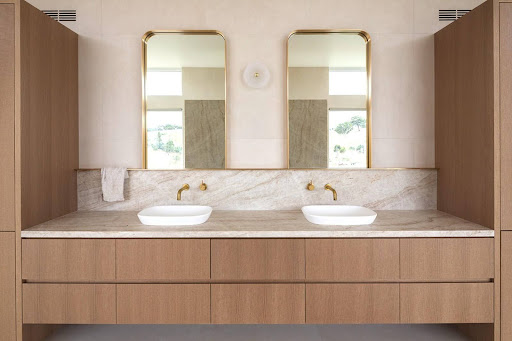
If you would like some help with your forthcoming renovation or interiors project please feel free to reach out to us here – we’d love to help you!
Photo credits:
Cosmo
Surfaces
AnteriorXL
CDK Stone
Cabex Construction
BC STONE
Cdk Stone

19 Jul
The Art of Styling Bookshelves & Tables: Transforming Your Space with Charm and Personality
Today, we’re diving into one of my favourite aspects of home styling: bookshelves. A well styled bookshelf can be a game changer in the look and feel of a space. These versatile pieces are more than just storage solutions—they’re an opportunity to infuse your space with charm, personality, and a touch of your unique style. Whether you’re a seasoned decorator or just starting your journey, I’m here to guide you through the process of creating a bookshelf display that not only looks stunning but also reflects who you are.

Begin with a Clean Slate – Before you start styling, clear everything off your bookshelf. This step allows you to see the space with fresh eyes and opens up possibilities you might not have considered before.
Plus, it’s a great opportunity to dust and clean those shelves! As you remove items, consider which ones you love and want to feature and which can be stored elsewhere or donated.
Go Big – Always arrange your largest items first. This will help you establish the scale and balance of your bookshelf. You can then arrange smaller items around these.
Embrace the Power of Books – Books are the heart of any bookshelf, so let’s make them shine. Start by grouping books by size and colour for a cohesive look. You can arrange them vertically, stack them horizontally, face the cover out or even face the spine backwards to give a neural look (that will make it hard to know what book they are though!). Don’t be afraid to mix things up – combine different combinations for visual interest.
Consider creating small clusters of books, alternating between vertical and horizontal stacks. This approach not only breaks up the monotony but also provides varying heights for other decorative elements.
Add Personal Touches – Now that your books are in place, it’s time to add some personality as you style the rest of your bookshelf. Think about the items that make you smile – treasured holiday finds, family photos, heirlooms, quirky trinkets and your latest purchases all give shape to the arrangement and inject personality.


Layering and Variety – When adding decorative objects, vary their sizes and shapes to create a dynamic look. For instance, a small sculpture can sit atop a stack of books giving it height and greater presence; framed photo can lean against a row of upright books or be placed at the back with smaller items in front.
Remember, odd numbers of items tend to look more visually appealing. Arrange little vignettes of varying heights together in groups of 1, 3 or 5 and imagine each as its own little scene that is linked to its neighbour.

Introduce Greenery – Plants are a fantastic way to bring life to your bookshelf. They add a touch of nature, freshness and vitality which can soften the overall look. Consider small potted plants like succulent, personally I love a trailing Devil’s Ivy for its ultimate low maintenance style. If you are worried about maintenance, high-quality faux plants are a great alternative.
Play with Texture and Color – A well-styled bookshelf isn’t just about what you put on it, but how those items work together. Pay attention to texture and colour to create a harmonious display. Mix materials like wood, metal, glass, and ceramics to add depth and interest. For colour, choose a palette that compliments your room’s decor. Neutral tones can create a calming effect, while pops of vibrant colours can energise the space but it is best to stick to no more than 3-5 colours and spread them out.
Utilise Bookends – Bookends are not just practical; they’re also an opportunity to add style. Look for bookends that complement your decor—anything from sleek, modern designs to vintage finds can work. They can also be a fun way to express your personality.
Create Visual Balance – When styling your bookshelf, aim for visual balance rather than perfect symmetry. This means distributing colours, shapes, and sizes evenly across the shelves. For example, if you have a tall vase on the top left shelf, balance it with a tall object towards the lower right. This approach keeps your display looking cohesive and pleasing to the eye.

Incorporate Art – Art isn’t just for walls—your bookshelf can be a mini gallery too! Incorporate small framed prints or photos to add an artistic touch. You can lean them against the back of the shelf or even layer them in front of books. This adds another layer of depth and personalization to your display.

Creating Joy – Remember, there’s no right or wrong way to style a bookshelf. It’s all about creating a space that makes you happy. Your home is a reflection of you, and every detail, from the smallest trinket to the grandest piece of art, tells your story. Enjoy the process, and don’t be afraid to experiment. Design is all about finding joy in the journey and creating spaces that bring you happiness and comfort.
Rotate and Refresh – One of the best things about styling bookshelves is that they’re not permanent. Feel free to rotate items and refresh your display whenever you like. This keeps your space feeling dynamic and allows you to showcase new finds or seasonal decor. Plus, it’s a fun way to keep your creativity flowing!
Happy decorating! But as always if you would like some help with a forthcoming renovation or interiors project please feel free to reach out to us here – we’d love to help you!
Photo credits:
Public311design
LivingetcOfficial
Theluxecollective
TaraNelsonDesigns
TheEveryGirl
SarahBirnie

05 Jul
Laundry Love-up!
OMG, where does all the washing come from?
I swear my family produces five items for every one of mine… Sound familiar?
If you’re nodding along, you’re not alone! Laundry is one of those never-ending household tasks, especially for busy families. But what if doing laundry didn’t have to feel like such a chore? Imagine having a laundry room so well-designed that you actually enjoy spending time in there.
Here on Sydney’s beautiful Northern Beaches we all love the outdoor lifestyle but that often means loads of laundry… gym gear, football gear, hiking gear, beach towels and that’s before we even get to the day to day wear! I love putting my interior design skills to work helping families transform their laundry spaces into efficient, stylish havens. Here are my top must-haves for creating the laundry of your dreams:


Hanging Space for Rainy Days – Rain or shine, your laundry routine shouldn’t skip a beat. Internal hanging space is perfect for those rainy days when outdoor drying isn’t an option. Be sure to avoid damp clothes getting in the way of the room’s functionality when in use and look for options that will neatly store out of sight when they’re not needed.


Underfloor Heating for Quick Drying in Winter – Lux! Underfloor heating is the ultimate luxury in a laundry room, especially during the chilly winter months. It speeds up the drying process and keeps the space warm and cosy and free of damp and mould.
Consider installing it in the wall if you are having wall mounted drying racks.

Concealed Laundry Hampers – A tidy laundry room starts with hidden hampers. Concealed laundry hampers keep dirty clothes out of sight and help you sort them efficiently, maintaining a clean and organised space.
Open Shelving for Plants and Pretties – Open shelving isn’t just practical – it’s an opportunity to add a touch of personality to your laundry room. Display your favourite plants, decorative jars, or just about anything that makes you smile.
Ironing Board & Broom Storage – Integrated storage solutions for your ironing board and brooms keep everything you need within reach but neatly tucked away. No more tripping over awkwardly placed items!
Maximum Benchtop for Folding Clothes
– Who doesn’t need more bench space? A spacious benchtop is a game-changer for folding and sorting clothes. It gives you plenty of room to spread out, making the folding process quicker and more efficient.
Room to Move! – A cramped laundry room can make chores feel even more tedious. Designing an efficient layout ensures you have room to move around with a place for everything, making the entire laundry process more comfortable. This apartment laundry was super tiny but we managed to fit the boiler, two machines, a retractable clothes line (tucked out of sight when not in use) with storage and benchtop space aplenty.


Plenty of Natural Light – Natural light can transform any space, making it feel brighter and more inviting. Large windows or skylights are perfect for flooding your laundry room with sunshine and allowing that much needed airflow..
Lush Tiles and Taps… Obvs! – Why not add a bit of luxury? Beautiful tiles and stylish taps can elevate the look of your laundry room, making it a space you’re proud of and happy to spend time in.
What are your non-negotiables?
Everyone has different needs and preferences when it comes to their laundry space. What are your must-haves? Whether you’re dreaming of a more organised, efficient, or just plain beautiful laundry room, we’re here to help make it a reality.
If you would like some help with your forthcoming renovation or interiors project please feel free to reach out to us here – we’d love to help you!

Photo credits:
Orli Interiors
George and Willy
The Block Shop
Arquette
Interiors Adp
Australia
Orli Interiors
Three Birds
Faucet Strommen

01 Jul
Harmonious Hallways and Enticing Entries: Balancing Functionality and Style in Tight Spaces
Here on the Northern Beaches space is often at a premium. Whether it be the long thin hallway of an early 1900’s home or the small entryway of a more modern build, when it comes to styling a narrow or small hallway, design choices can make a big impact.
Here are some of the tricks I use as an interior designer to deal with these often difficult spaces.
Set the tone for the home – The primary palette for this home was a simple monochrome scheme warmed with an abundance of natural timber, layered textures and earthy shades of terracotta.
The solid oak door jambs and oak internal doors along with black accents in the door handles, picture frames and black striped jute runner all help to introduce the look to anyone entering the house.
Runners and rugs – Use a runner or rug to add texture and colour. Remember this will be a high traffic area so make sure you use a durable piece.
This one is a low cost jute rug that doubles as a doormat to ensure shoes are clean by the time you make it to a chair to take them off; something to consider if you don’t have space for a bench seat.

Play with Patterns and Textures – Introducing different textures and patterns can add visual interest to a narrow hallway without overwhelming the space. Consider incorporating textured wallpaper or wall panels to create depth and dimension. Mixing and matching materials like wood, metal, and glass can also add richness and character to the design.

Lighting – A super important element in your hallway. It will stop the area feeling dark and dingy. In this renovation I added skylights which completely transformed what was a dark and narrow space, along with timber disc wall lights to create a warm and inviting atmosphere in the evening, while appearing more sculptural during the day. A gorgeous pendant or two is another great way to wow your visitors. Remember to make the light switch easy to find – when you step in at night the last thing you want to be doing is fumbling around in the dark.

Add a statement mirror – If skylights aren’t an option consider installing a mirror opposite a source of natural light from another room to increase ambient levels while also giving the impression of more space.
Incorporate Natural Elements – Bringing elements of the outdoors inside can help create a sense of harmony and tranquillity in your hallway. If space permits (maybe those floating shelves would be a good spot!), consider adding potted plants or a small indoor garden to infuse the space with greenery and natural beauty. Not only do plants improve air quality, but they also add a touch of colour and freshness to the environment.

Add a statement mirror – If skylights aren’t an option consider installing a mirror opposite a source of natural light from another room to increase ambient levels while also giving the impression of more space.
Incorporate Natural Elements – Bringing elements of the outdoors inside can help create a sense of harmony and tranquillity in your hallway. If space permits (maybe those floating shelves would be a good spot!), consider adding potted plants or a small indoor garden to infuse the space with greenery and natural beauty. Not only do plants improve air quality, but they also add a touch of colour and freshness to the environment.
Add impactful art – Every space needs a statement piece and a corridor is no different; with floor space at a premium your walls are the go to for this. Go for something fun that makes you smile or a piece that reminds you of a favourite holiday.
By incorporating these design elements, you can transform your narrow hallway into a stylish and functional space that sets the tone for the rest of your home. Whether you’re welcoming guests or simply returning from a busy day, your hallway will make a lasting impression with its thoughtful design and attention to detail.
If you would like some help with your forthcoming renovation or interiors project please feel free to reach out to us here – we’d love to help you!

Photo credits: 1. Orli Interiors | 2. Orli Interiors | 3. Pursuit Decor | 4. Orli Interiors | 5. Orli Interiors

21 Jun
Wonderful Wallpaper: Tips from an Interior Designer
Wallpaper is a fabulous way to add personality, texture, and warmth to your space. As an interior designer I love using it to define a breakfast or study nook, create a stunning feature wall or transform a room with a ceiling application! With so many wallpapers available you will be sure to find a design that that you love and that reflects your unique personality.

Here are some things to consider when choosing wallpaper!
Consider the Room’s Purpose – Is it a cosy bedroom, a bustling kitchen, or a calm home office? The function and purpose of the space will influence your choice of wallpaper. Bold patterns work well in high-energy spaces, while calm and serene designs are better for bedrooms and other relaxing areas. Wallpaper is great for adding an element of fun in a child’s bedroom or playroom. But remember that for high-traffic areas, like hallways, playrooms or kitchens, it is best to opt for durable, washable wallpapers that can stand up to daily wear and tear. In bedrooms or living rooms, you can get away with more delicate, luxurious options.

Take Room Dimensions into Account – The size of the room and the height of the walls will also impact the appearance of the wallpaper. Consider the scale of the design and make sure it will look proportionate to the space. In small rooms, opt for smaller-scale prints to avoid overwhelming the space.
Conversely, larger rooms can handle bolder, more expansive patterns without feeling cramped. And if you’re working with low ceilings, vertical stripes can create the illusion of height, while horizontal stripes can make a room feel wider.
Think About Lighting – The amount and type of light in a room will affect the appearance of the wallpaper. Sunlight can bring out the true colours and textures of wallpaper but depending on the direction and intensity of sunlight, the appearance might change throughout the day. When it comes to artificial light; warm-toned lights may make the colours appear richer and more vibrant, while cooler lights can create a more subdued or crisp effect.
Placement of light fixtures can also add to the patterns and textures of wallpaper – accent lighting, such as well placed wall sconce, can draw attention to particular areas of the wallpaper or an architectural detail. This can create a focal point within the room and highlight the unique features of the wallpaper design.
Play with Patterns and Coordinate with other Elements – One of the most exciting aspects of wallpaper is the endless array of patterns and designs available. From classic stripes and florals to bold geometric prints and whimsical motifs, there’s something for every taste. Don’t be afraid to get creative and experiment with different patterns – just remember to keep our above tips on scale and proportion in mind and don’t forget to coordinate it with other elements such as furniture, flooring, and window treatments. to ensure a harmonious look.

Embrace Texture – While patterned wallpapers often steal the spotlight, don’t overlook the power of texture. Textured wallpapers can add depth and dimension to a room, creating visual interest and tactile appeal. Linen wallpapers can be a timeless addition to any room, while sisal really comes to life on the walls. Other luxurious finishes like velvets will take on a 3D appearance while a bouclette wallpaper creates exceptional depth. Check out @casamance_official for some great inspiration here!”Mix and match textures for a dynamic look that’s uniquely yours.
Go Beyond Walls – Who says wallpaper is just for walls? Get creative and think outside the box by using wallpaper to accentuate other areas of your home. Consider lining the backs of bookshelves for a pop of colour, covering cabinet fronts for a stylish makeover, or even framing wallpaper as art for a one-of-a-kind focal point.
The possibilities are endless!


Dull the Noise: Acoustic wallpaper offers a dual benefit of enhancing both the aesthetic appeal and the acoustic performance of a home. Beyond its visually pleasing designs, this innovative wallpaper absorbs sound, reducing echoes and minimising noise levels within the living space, a big plus in the world of open plan living. Whether applied in a living room, a home office, or bedroom, acoustic wallpaper creates a quieter, more comfortable environment. Its seamless integration into interior decor makes it a versatile solution for noise control without compromising style.
This linen wallpaper has a foam backing for an acoustic effect.
Test Samples – Once you’ve narrowed down your options, it’s time to bring home some samples and see how they look in your space. Lighting can have a significant impact on how a wallpaper appears, so be sure to test your samples in different areas of the room at different times of day. And don’t forget to consider how the wallpaper will complement your existing furniture, decor, and colour scheme.

Do You – Your home should be a reflection of your own personality and taste, so let your personal style guide your wallpaper selection. Are you drawn to sleek and modern designs, or do you prefer something more eclectic and bohemian?
Understanding your aesthetic preferences will help narrow down your options and make the decision-making process easier. Don’t be swayed by trends or opinions. If you love it, that’s all that matters! And remember, wallpaper is not a lifelong commitment – if you ever tire of your chosen design, it’s relatively easy to remove and replace.
“If you would like some help with your forthcoming renovation or interiors project please feel free to reach out to us here – we’d love to help you!”
Image Credits:
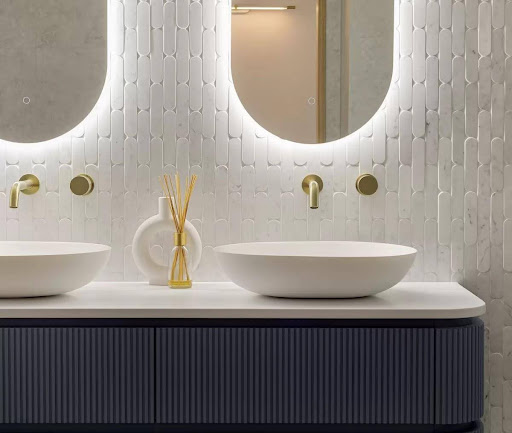
17 May
Leveraging Light for a Beautiful Bathroom
Let there be light!
… but where to put it in the bathroom?

Good lighting is essential when it comes to great bathroom design, for both functionality & ambience. When it comes to lighting, no matter which room in the house, a layered approach is the key. This is sadly often overlooked in the bathroom; it might be one of the smallest rooms in the house but with the right lighting it can still pack a punch! Here are our top tips to get your bathroom in the spotlight.
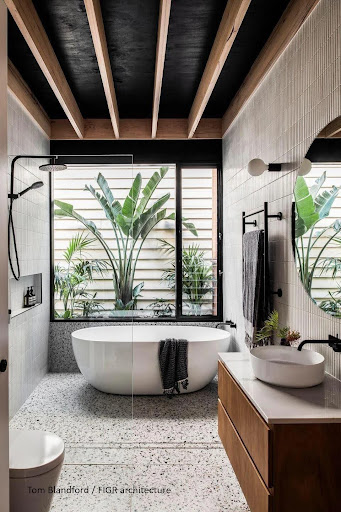
Natural Light – Nothing beats it! Natural light connects us to the outside world and helps regulate our circadian rhythms, whether it is waking us up in the morning or winding us down at night our body is programmed to respond to the light outside. Where windows are concerned the bigger the better – but don’t forget some screening unless you’re planning on putting on a show for the neighbours!
Translucent glass is the perfect way to let the light in without losing your privacy. Or if the orientation is right and you have the space consider planting some lush foliage outside your bathroom window.
If you are concerned about privacy, or you are short on wall space, then high windows are a great option for introducing light without compromising these other factors.
Bounce it around – Large mirrors are not only useful in a bathroom to ensure you step out looking your best, they can do wonders to increase the amount of light by bouncing it around the room… and don’t forget any reflective surface will do the same. A gloss tile option is a great means of increasing perceived space and light in a small bathroom.
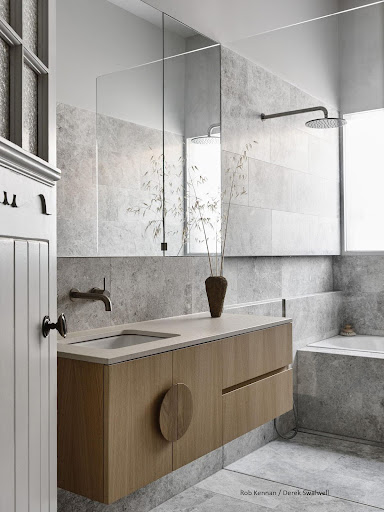
Skylights – If, like in this recent project, the bathroom is in the middle of the house, a skylight is a fabulous option. Skylights add a special touch to any bathroom and I would always recommend adding one over the shower or bath where it is a possibility, with or without windows. I just love to be able to look straight up at the blue sky in the morning!


Now you have your natural light sorted, build up the other lighting you need for all the different bathroom uses of your bathroom:
Consider the colour – YES light has colour. The colour temperature of your light bulbs can greatly impact the mood of your bathroom. Opt for warmer tones (around 2700-3000 Kelvin) for a cosy, spa-like atmosphere, while cooler tones (4000-5000 Kelvin) are perfect for a crisp, energising feel. Daylight downlights above the sink area can complement wall sconces for those occasions when you need ultimate clarity. Experiment with different temperatures to find the perfect balance for your space, this is as easy as changing a light bulb!

Mind Your Mirror – The mirror is the star of the show in any bathroom, so it deserves special attention when it comes to lighting. Ensure that your vanity lights are evenly spaced and mounted at eye level to minimise shadows and provide flattering illumination. If space allows, consider adding a backlit mirror for a modern touch.

Pay Attention to Placement: When installing your lighting fixtures, pay attention to placement to ensure optimal functionality and aesthetics. Avoid placing lights directly above the mirror, as this can cause unflattering shadows. Instead, position them on either side for even illumination. For ambient lighting, aim for uniform coverage throughout the space.

Accessorise with Style – Last but not least, don’t forget to accessorise! Light fixtures are not only functional but also decorative elements that can enhance your bathroom’s style. Choose fixtures that complement your existing decor—whether it’s sleek and modern or classic and timeless.
If you would like some help with your forthcoming renovation or interiors project please feel free to reach out to us here – we’d love to help you!

03 May
Choosing Chairs? Selecting Stools?
Top Tips to Find the Right Ones for You
A recent reno – or even just update – on your kitchen or dining area can mean it’s time to get some new seating in place to match that stylish new look. Be that dining chairs, bar stools or both, I’ve got you covered.

With the rise and rise of open-plan living there’s a lot less need these days for a separate dining room, or separate furniture to go within it. This means that today’s kitchen-diner seating has to be more multi-functional – and multi-stylish – than ever… covering occasions from breakfast to home-working to dinners with friends.

When designing an interior finishes scheme, all furniture within it should work in harmony. Consider the planned style of the space around your seating. Is there a particular era or aesthetic you’re going for? A contemporary look might involve complementing sleek lines alongside luxury finishes and textures whereas a more casual coastal scheme might employ natural timber, breezy ocean tones and textured organic finishes like rattan and linen for a more lived-in look.
Where is your dining table to be located and have you ensured this is the best spot for it? If space is tight, opt for a smaller arrangement that won’t overwhelm the space and doesn’t restrict the general flow of traffic around the home. Think about putting the table against a wall if needs be or building in a dining bench if you feel the latter could be unavoidable. Before buying that huge table just for Christmas day gatherings, remember it’s best to furnish your house for everyday use rather than for the occasional event once or twice a year – an extendable table could be just the ticket, but they do come at a premium.

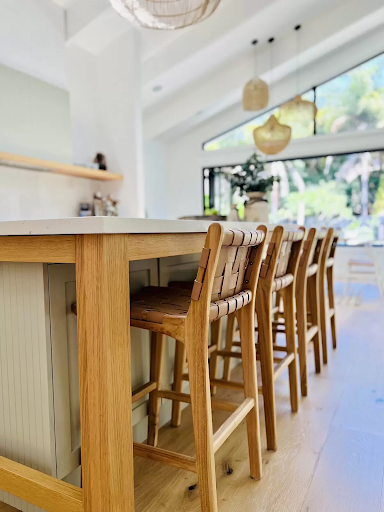
If you’re keen on wooden seating, the timber you choose will likely be influenced by your chosen scheme. Light timbers generally work best for Scandi and coastal looks, while darker timbers suit mid-century or heritage styles – though the chocolate tone of walnut works wonderfully in both moody and modern settings as well as the more classic styles. Beautiful rattan has also made a huge comeback in recent years, and evokes everything from upmarket Palm Springs, through vintage boho to colonial tropical vibes.
Think also about how your seating will work with the surface it will surround. What is the table or benchtop itself made of? Timber is the most popular dining table choice, in which case, either use the exact same material for your chairs or contrast definitively against it; something that’s ‘almost the same but not quite’ could easily look out of place. For example a black timber chair with an oak table is a great match; similarly an upholstered or leather dining chair will make a great complement. For any seating-surface combo, think about what you want the room’s focal point to be: are your chairs or stools the standout feature, or the stunning table or bartop? If the latter, your seats might just provide simple complement or contrast. Or, if you want them to do the talking, you might choose a more show-stopping design or colour.

Wow-factor (if desired), along with your chosen scheme, will influence whether you employ colour, and how. If you do want your seating to pop, your chosen colour can make a bold statement in some way within the rest of your scheme (though for most aesthetics think complementary rather than clashing). Crisp whites and striking blues marry perfectly with the ever popular Hamptons look while rich block colours remain chic and contemporary in a minimalist setting. A pair of table end-chairs in a contrasting colour and style to the main collection of chairs can also make a great statement – and don’t forget to add a striking pendant light to finish the look.
For chairs to play a quieter role; focus on matching timber chairs and table or at least veer towards tonal differences of the same shade used elsewhere in the home; muted hues look great among traditional, coastal or Scandi schemes.
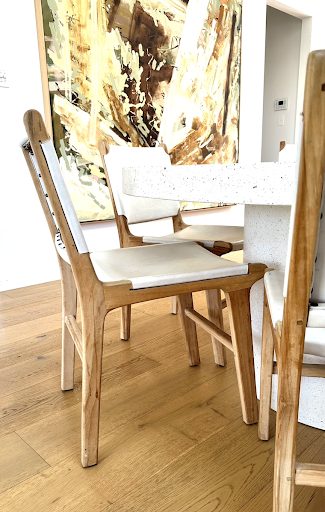
Before taking the plunge on this particular investment, be sure also to look beyond your home and take note of any seating that you feel works particularly well with the surrounding décor. While social media channels will yield endless images, getting amongst it can also help you appreciate the cohesion of a well curated scheme; aside from the obvious interiors stores; stylish eateries, bars, shops and salons can also be a great source of inspiration.



Consider the likely wear and tear for your chairs or stools, especially if you have young children or pets. If you do, any finish that’s super-sensitive to bumps or scratches, or any fabric difficult to remove or wash, is probably not for you. Yes, that includes the velvet-upholstered chairs you may have been eyeing up for some time (it’s a fact I struggle with myself – surely I can convince my cats not to destroy the chairs I so desperately crave?!) And as with any hard-working furniture, especially that which has to support a person’s weight, invest in the best quality you can afford and you’ll be rewarded with a solid item that gives you years of use.

Please do your homework and take the time to get accurate measurements for your seats to avoid costly pitfalls. Standard dining-table height is between 71 and 76cm while the average chair seat is 47cm high.
Between the chair’s seat and the underside of the table top, or the table-rail if there is one (the wooden ‘pelmet’ that skirts around the sides of the table) you should be aiming for around 24-30cm, with 26cm being the ideal to allow enough space to manoeuvre in and out. You’ll also need to consider the space widthways around each chair, with most experts recommending about 15cm of elbow room between each – overall around 70cm per person is a comfortable seating width and will allow your chair to be pulled out without disturbing your neighbouring diner.
Remember also you will need to check the distance between the legs of the table to ensure that all chairs can be pushed under the table and that no one has to sit with an uncomfortable table leg between theirs. If your chairs have arms – be sure they will fit under the table and they are at a comfortable height for your guests. Finally allow around 70-90cm behind each chair to allow for easy pulling out and definitely no less than a metre between the table edge and the nearest wall or obstacle.
For bar stools and bar tops, although the overall heights will exceed those of tables or chairs, the important distance to consider is still that between your lap and the ‘leaf’ or surface top. For the average adult not to be slouching forwards if the stool is too high, or stretching up if it’s too low, you want to aim for around 23-28cm of space between lap and counter top. Again, around 15cm either side of each bar stool is recommended for wiggle room, though when measuring stools do take into account if they have arms, which will add extra width beyond just the seat.

A mix of practicality and preference… Do you want backrests? This could make them more comfortable to sit in for longer periods, like casual dinners. Having stools that swivel can also make them a bit more manoeuvrable, especially in tighter spaces, though they often cost more and can become pesky if you have young children who see them more as toys than furniture (and yes, I’m speaking from experience!) But whatever you do, ensure that any stool has, for comfort, a decently-placed foot rest for the average adult. Too high and it’s cramp-inducing but too low and numb, dangling legs can soon ruin relaxation.
For any seating you choose, take a seat – literally, make sure you sit in it first! There’s nothing worse than an uncomfortable chair or stool, so always try before you buy. And if not – check the returns policy!
If you need any help furnishing your home please do reach out for a chat, we’d love to help!
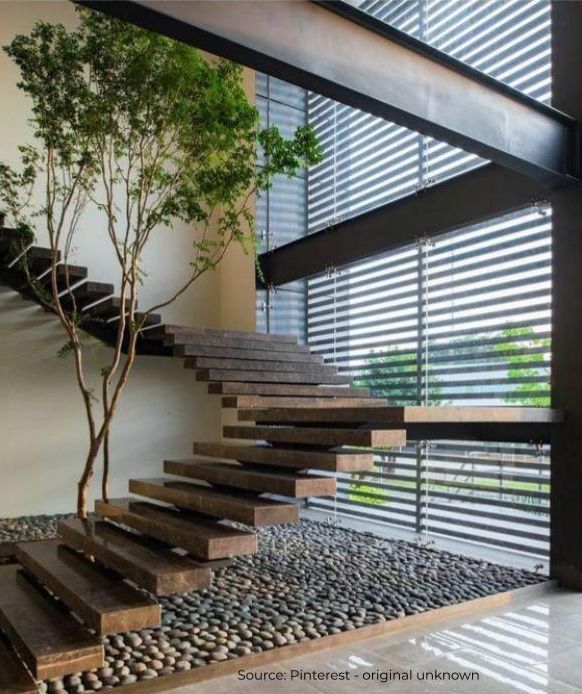
17 Apr
Stellar Staircases
Designing a staircase can bring a lot of challenges in terms of both function and form. That said, with the right approach and know-how, you can create one that works perfectly while also adding some wow-factor. Here are some tips for doing just that:
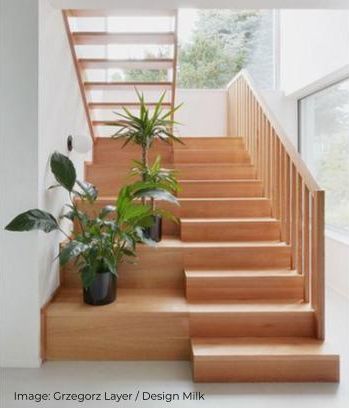
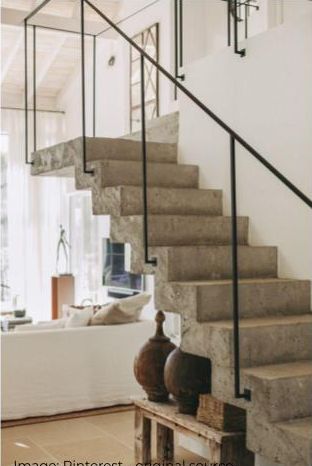
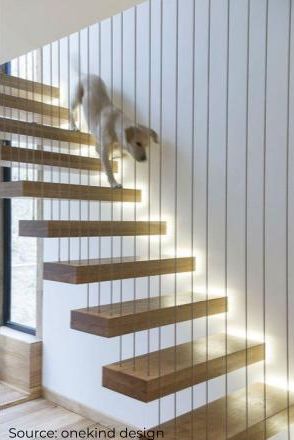
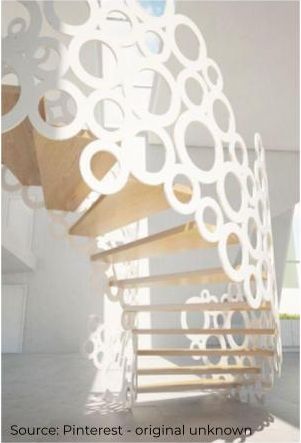
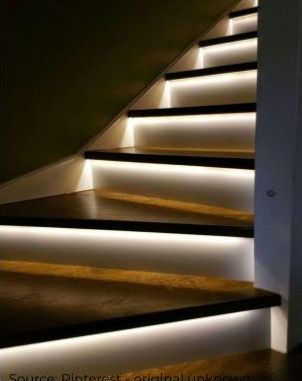
5. Make it a focal point: A staircase can be a great way to create a focal point in your home. Use a combination of materials, unique shapes and eye-catching details to make it stand out. Some of my favourites definitely add serious drama to something that could just be ho-hum functional! I sometimes dream of an enormous house with a deliciously curved white spiral staircase sweeping up into a great void which channels the light from an overhead custom round skylight back down into the ground floor.

6. Incorporate storage within the stairs: If space is limited, consider incorporating storage into your design. Open shelving, closed cabinets or drawers, or custom joinery such as a reading or study nook can all help to make the most of an often awkward space. And yes, there are staircases where the risers in the stairs (the vertical bit) are made into drawer fronts, with the drawers themselves sliding underneath each stair. Clever, hey?
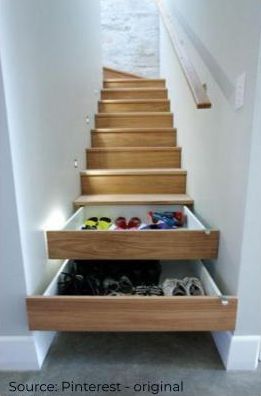
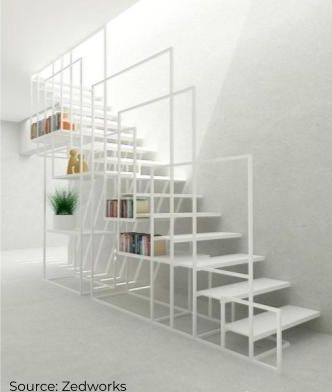
i) An extra feature that this floor might really need, which usually comes from something you might be struggling with. Could you do with a powder room on this floor? Are you short on coat-hanging/shoe-stashing space? What about a study or reading nook, away from the hustle and bustle of the kitchen or living room area? The possibilities are endless – with a bit of clever thinking you can solve many of these niggling issues.
ii) A joy-inducing feature which you simply have the space for now. Who said wants couldn’t become needs? If you’re looking beyond just utility, celebrate this space with a lovely display area. Those personal treasures and family photos aren’t going to put themselves on display! Your home is your own personal sanctuary – take care to create little pockets of joy and inspiration wherever you can and I promise it will lift your spirits every time you wander past.
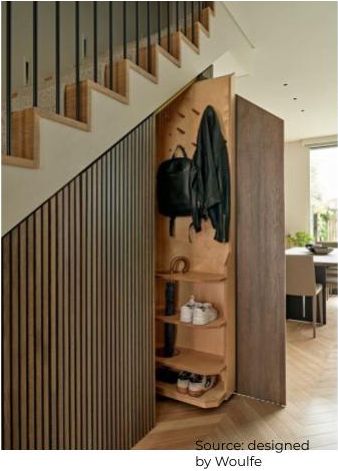
8. Consider safety: Safety should always be a top priority when designing a staircase. Make sure the steps are the right size, have enough traction, and are well lit. Here are the basics of legal stair design to bear in mind:
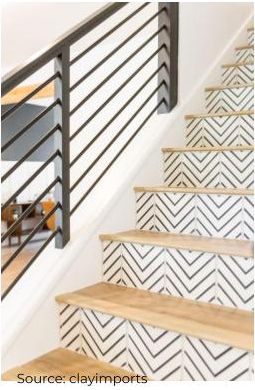
– As a rule, your staircase must have no fewer than 2 risers or have no more than 18 risers without a 750mm2 landing or rest area.
– A staircase should have no more than 36 risers without a change of direction.
– Risers must be between 115-190mm high and Goings or Treads (the horizontal bit) must be 240-355mm deep.
– Stairs themselves can’t be less than 600 mm wide measured between the inside edges of the handrails.
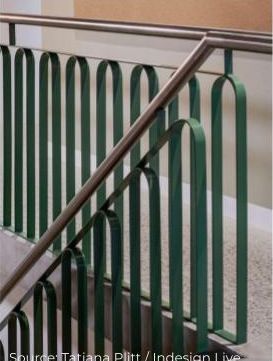
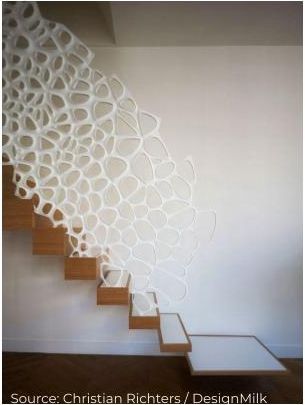
10. Finally, add personal touches: This can make your staircase truly your own. You can add artwork, family photos, or even plants to create a warm, inviting space.
Remember, designing a staircase is about finding the right balance between function and aesthetics. By considering these tips, you can create an impactful, well-designed staircase that is both beautiful and functional.
If you would like some help with your forthcoming renovation or interiors project please feel free to reach out – we’d love to help you!

29 Mar
How to plan the perfect kitchen

The kitchen has long been the heart of the home, but with open plan living now more the norm than ever before, the kitchen has also become an extension of your living space and its design should reflect that. An interior designer will take a holistic view of your kitchen renovation with the rest of the home’s aesthetic in mind. But before we even get to the look – there’s lots to consider! Here are my top tips for anyone looking to renovate their kitchen.

1. Define Your Style: The first step in any kitchen renovation is to decide on the style you want for your space. What’s your go-to look? Pinterest is a great place to start to define your style if you’re unsure. This will guide your choices for materials, colour schemes, and design elements. From coastal to minimalist, hamptons to farmhouse, choose a style that speaks to you and your family’s lifestyle
2. Plan Your Layout: Consider the flow and functionality of your kitchen when planning your layout. This includes considering the triangle of work, which consists of the sink, refrigerator, and cooktop. The sum of the three sides of the triangle should ideally not exceed about 7-8m and no leg of the triangle should be less than 1.2 m (4 ft) or more than 2.7 m. Make sure they are positioned in an efficient and easily accessible manner. Additionally, think about the amount of counter space you need and where it should be located, and where your china, glass and cutlery cupboards are in relation to the dishwasher. I always like to position a pull out bin underneath the main preparation surface for easy disposal of food debris.
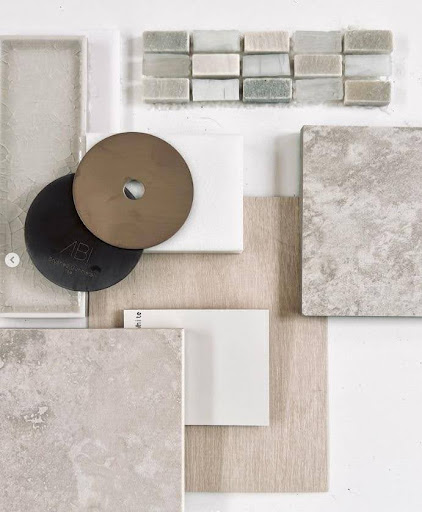
3. Choose Durable Materials: The kitchen is one of the most heavily used spaces in the home, so it’s important to choose materials that can withstand frequent use and are easy to clean. Countertops, cabinets, and flooring should be durable and low-maintenance. For example, quartz, granite, or solid surface countertops are a popular choice for their durability and ease of cleaning, though please don’t underestimate the beauty of natural stone. It requires a lot more TLC but is a no brainer when it comes to that high end finish and unique look.
4. Maximize Storage: No matter how large or small your kitchen is, maximizing storage is key. Use vertical space by installing shelving, cabinets, or open shelves to store items. Consider using corner cabinets with rotating shelving for added storage and accessibility. Additionally, consider creative storage solutions, such as pull-out pantry shelves & drawers or under-cabinet baskets, to make the most of every inch of space. Storage can be incorporated into the front of your kitchen island and extra deep tall units could open up opportunities for hidden end cupboards and a large corner pantry. For those with the luxury of space, a butler’s pantry offers enormous potential for storage tucked out of sight from your main entertaining zone, but if that is not an option consider an appliance / breakfast cupboard to keep everyday items within easy reach but away from view when not in use.
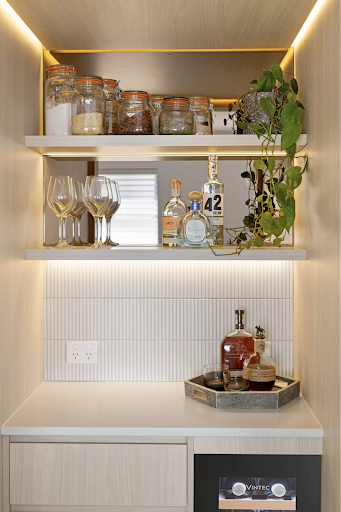
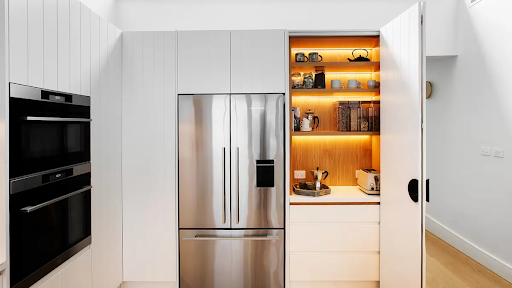
5. Incorporate Lighting: Good lighting is essential in the kitchen, both for practical reasons and to create a warm and inviting atmosphere. Consider installing a combination of dimmable overhead lights and under-cabinet lighting to provide ample illumination. Additionally, task lighting such as pendant lights or a countertop light should be used to highlight specific areas in the kitchen. Open shelves with recessed lighting are a great way of adding decorative lighting and can be styled with living greenery and a curated collection of treasured objects to help blend your kitchen with your living spaces.
6. Invest in Appliances: High-quality appliances that will stand the test of time can greatly improve the functionality of your kitchen and make cooking and meal prep a breeze. Invest in energy-efficient appliances, such as an induction cooktop, a dishwasher with a delay start option, or a refrigerator with a built-in ice maker, to help reduce your energy costs and benefit the environment. Give careful consideration to the size of your appliances – especially your fridge freezer – to be sure it will accommodate the needs of your lifestyle, and always check the warranty!
7. Backsplash: Good lighting is essential in the kitchen, both for practical reasons and to create a warm and inviting atmosphere. Consider installing a combination of dimmable overhead lights and under-cabinet lighting to provide ample illumination. Additionally, task lighting such as pendant lights or a countertop light should be used to highlight specific areas in the kitchen. Open shelves with recessed lighting are a great way of adding decorative lighting and can be styled with living greenery and a curated collection of treasured objects to help blend your kitchen with your living spaces.
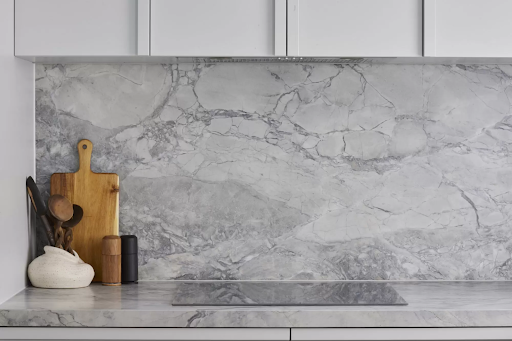
8. Install an Island: If your floor plan allows it, an island can provide extra counter space and storage, making it an excellent addition to any kitchen renovation. The fascia of the island offers great opportunities for colour and texture and, like your benchtop and backsplash, is a key consideration for the overall aesthetic. Consider adding a sink or cooktop to the island for additional functionality, though be aware that you may find you are constantly looking at last night’s washing up! Personally – if space permits – I like to keep an island or peninsula clear to give an uncluttered space for use as additional seating for casual meals or pre dinner drinks when entertaining.
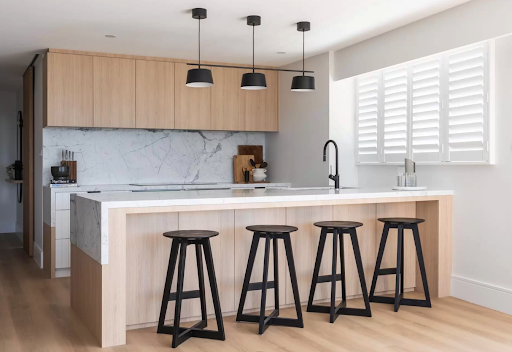
9. Focus on Ergonomics: Ensure that your kitchen is comfortable and easy to use. This means making sure the countertops are at the right height – generally I specify 920mm measured from the finished floor level to the top of the benchtop, but 950mm is a good height for tall people and 900mm for shorter people. The cabinets need to be easily accessible, and the appliances should be positioned in a way that is easy to reach and use. We don’t need to be breaking our backs every time we make dinner! Additionally, think about adding a comfortable seating area, such as a breakfast nook, to make the kitchen more inviting.
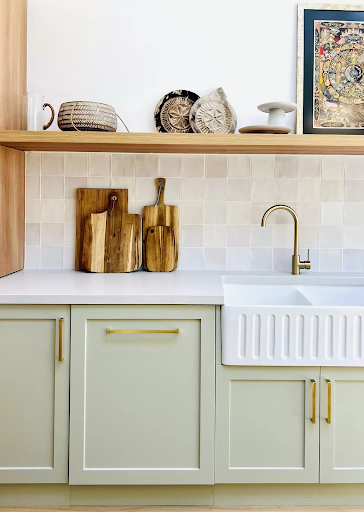
10. Aesthetics: Choose a consistent color palette that reflects your interior design style and creates a simple foundation to the overall look of the rest of your home. Highlighting key elements that define your interior, such as cabinetry and hardware finishes used elsewhere in the home also helps to bring a sense of cohesion. Rhythm and repetition throughout a home really does feed the flow from room to room to ensure each space works in harmony with the next. And don’t forget the kitchen is just as much a living space as the other rooms in your home, so be sure to showcase those personal touches such as decorative accessories, artwork, and statement pieces or treasured finds that help to tell a story about the person who lives there.
11. Don’t Forget the Details: Finally, don’t forget the small details that can make a big impact in your kitchen renovation. This includes things like cabinet handles, lighting fixtures, and accessories. Choose items that complement your style and add to the overall look and feel of your kitchen. Small touches, like a vintage pendant light or unique cabinet hardware, can make all the difference in creating a cohesive space with genuine personality.
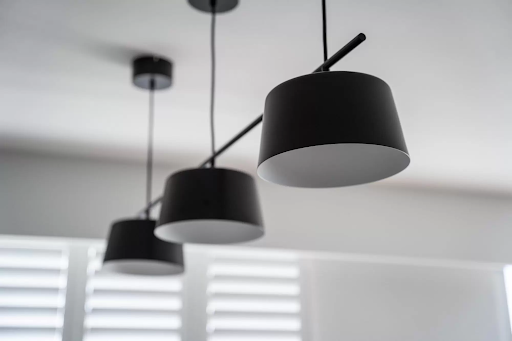
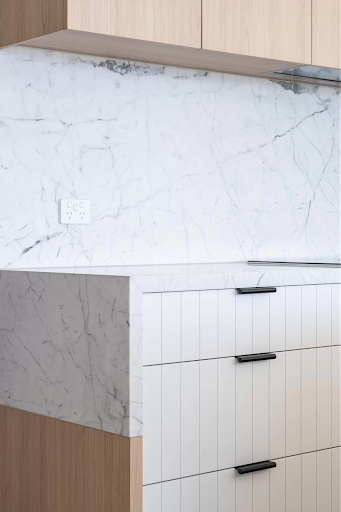
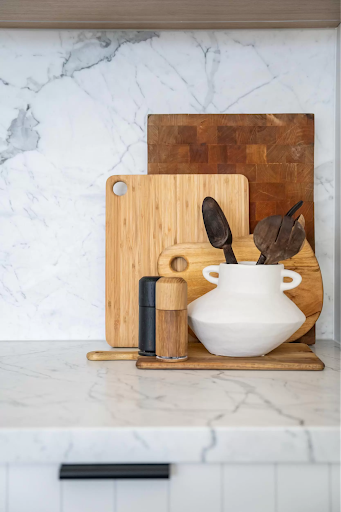
If you’re struggling to figure it all out and you are looking for a Northern Beaches Kitchen Designer to help you realize your culinary dreams, please do drop us a line – we’d love to help!



24 Jul
How to design the perfect home office
OK, so you need to work from home. And by that I mean actually work, be productive, get stuff done… we’re not talking about the “WFH” wink wink scenario here… so here’s a few simple steps and considerations to help you get yourself up and running and finishing each day with a whole heap of satisfying ticks next to your list of “things to do”.
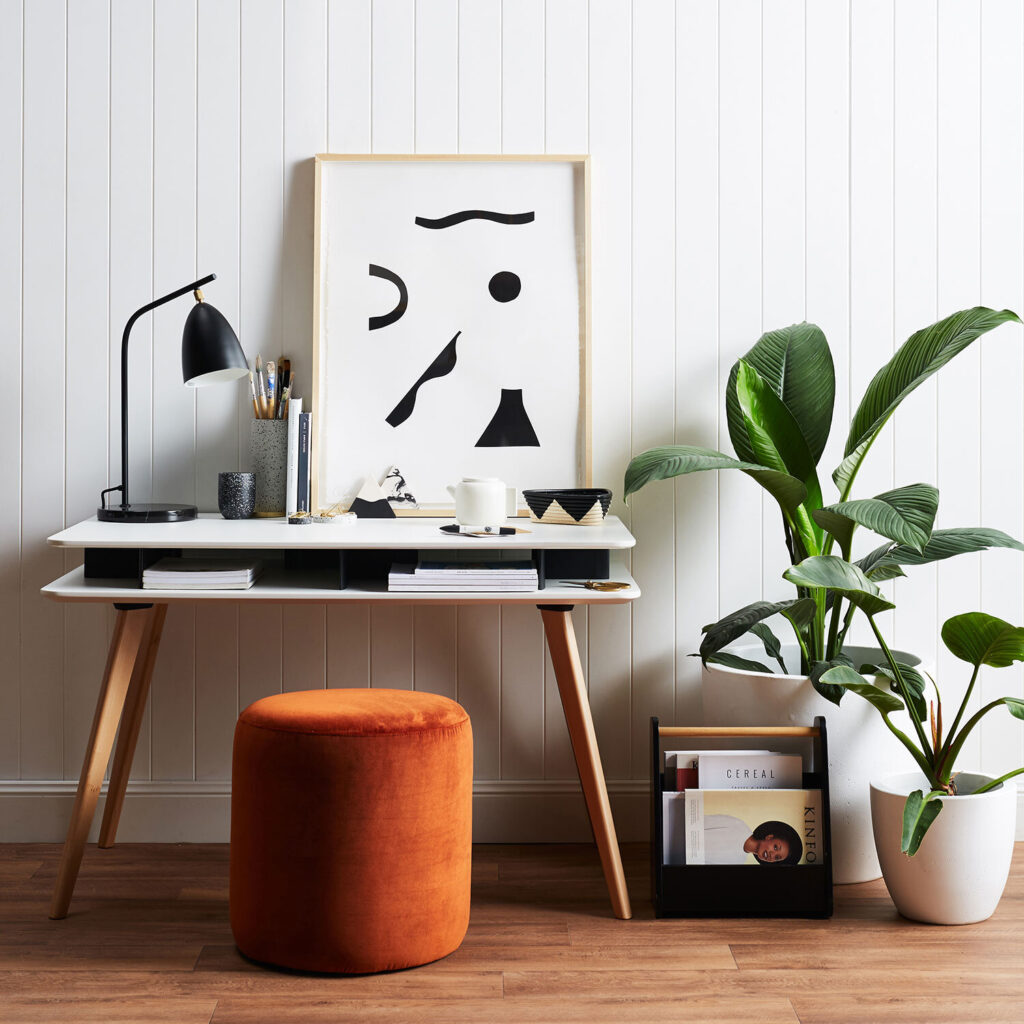
This is key, find yourself a nook away from the hustle and bustle of the house if possible, ideally a room that allows you to close the door on the world outside, and close the door behind you at the end of the day. If you’re not lucky enough to have a dedicated study, perhaps the guest room could offer some space, or that under-utilised spot in the hallway. Check that you have power sockets available and enough space to keep all the essentials at hand, as well as good proximity to a window.
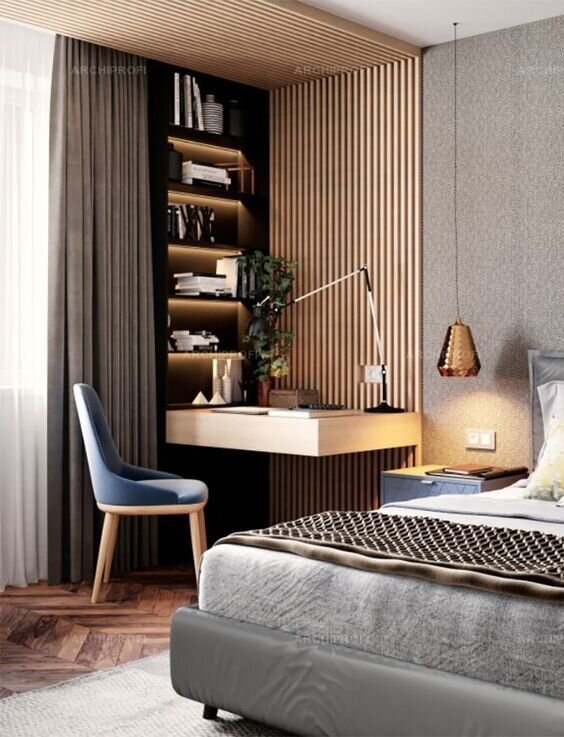
Make a list of everything you need in excel, or better still try using google sheets so you can access it any time, even on your phone when you’re out shopping. Estimate the cost for each item and establish a budget. You can update each product cost as you purchase to ensure you stay on track.
There are so many options out there, and your final choice will depend on the space you’re intending to use, but you should consider if you need a sit/stand option, can you build your desk in with custom joinery or do you need something less permanent? Think about how it will feel – personally I prefer resting my arms on the warmth of solid timber, a glass or polished top just feels too cold, but you will have your own preferences. Does it need built in storage or can you afford the space for drawers and / or shelves or cupboards? For optimum ergonomics allow a minimum depth of 60cm for your desktop, which gives sufficient space on top and underneath for legs, and ideally 150cm in width to accommodate writing space, laptop/monitor and an in/out tray and space for drawers under one side of the desk.

Even if you’re on a tight budget, be sure to invest in a good quality chair with sufficient support – your back, neck and joints will love you for it! It’s worth having wheels for ease of movement between drawers and printer if you have one nearby, and a swivel function will reduce the amount of twisting you need to do every time to get up. For those with back issues you will find that the flexibility of movement in chairs that recline and are height adjustable will make life so much easier, and subject to the level of lumbar support consider adding a cushion for comfort. I cannot tell you how many times I feel like I’ve aged 3 decades just by sitting in the wrong chair! Sadly my garden dining chairs just don’t cut it when it comes to sitting at a laptop all day… boo.
You may also need to think about adding a rug or runner to protect the floors, depending on the kind of chair you go for.

Look for more office chair ideas here
Clutter is a killer to productivity. Keep your lesser used items out of sight in a drawer, and only have the essentials on the desktop along with an item or two to style it up. Treat yourself to some smart stationery – an in/out tray to tidy up the paperwork, good looking folders for project organisation, matching stapler and hole punch, and a stylish vessel for your swanky new pens and pencils.
Make sure your cables are kept nice and tidy too – either with velcro cable tidy straps or in casing attached to a wall. I like to keep all our devices in one of our desk drawers to keep everything out of sight, which was simply a case of cutting a hole in the back of the unit and feeding the cables through – it’s definitely worth dedicating a drawer to this if you have the option.
Obviously make sure you have everything you will need at hand – printer (with ink! and ideally spare cartridges), paper, notebook, stapler, whatever it is, you don’t want to find yourself having to go rummaging around in your child’s craft box for it! (she says with a Frozen ruler stashed in her posh pencil case!).

If your home office is somewhere you are likely to spend a lot of time then it’s crucial to ensure you have plenty of natural light available. Not only does natural light boost vitamin D, but it also helps to ward off the ‘winter blues’ and promotes a better sleep cycle. This in turn makes for a more productive, healthier and happier workspace. For the night owls, ensure you have great overhead ambient lighting as well as a good level of task lighting in the form of a desk lamp. If your work space needs to allow different moods, for example if it is also used as a guest room or a kids tv room in the evenings, look into dimmable options and cool/warm bulbs that allow you to move between bright and subdued lighting levels to convert work mode into relaxation mode at the flick of a switch.
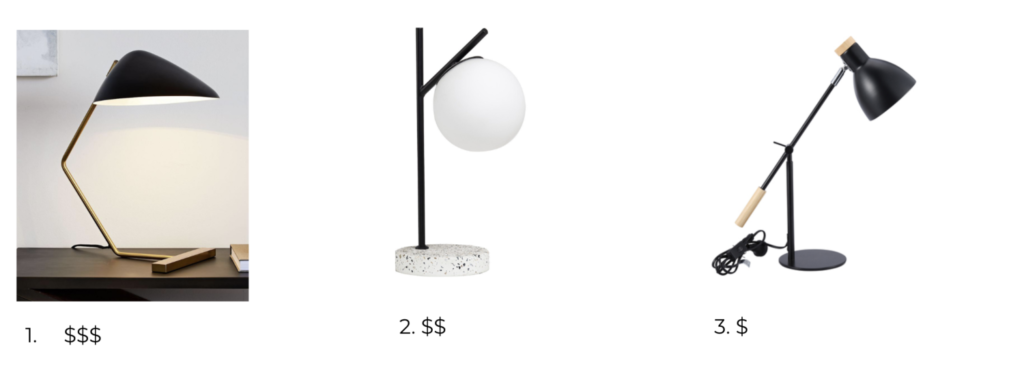
Just like natural light, the availability of fresh air is also critical for maintaining a healthy working environment. Your mum was right when she said the fresh air will do you good, and while I don’t need to reel off the numerous health benefits, it’s worth noting that fresh air also gives you more energy, vitality and a sharper mind and well, it will simply make you feel happier. No one wants to be stuck inside a stuffy office all day, and at home you shouldn’t feel you have to be. Even if you cannot open a window right by your desk, make sure you have windows and doors around the house open to allow air to circulate – it will do you and the whole family good! Try and take at least one of your breaks to go outside and feel the sun on your face too – I swear I am solar powered!
This may be an obvious point, but be sure to get the temperature right a the start of the day or it will most definitely interfere with your ability to stay focussed.
Often overlooked but a key aspect of the design of any space. An echoey room never feels inviting or comfortable, and if your work requires you to be on the phone a lot you will find it to be an enormous distraction, especially if there are two of you working. The key to avoiding this is to include soft furnishings and finishes to absorb sound. A spare bedroom will likely be readily equipped, but if not, consider including a small sofa, armchair or window seat if space permits – this also offers some variety of seating while talking to colleagues or reading documents. Carpet, rugs, curtains or blinds and artworks on canvas will also help to absorb sound while creating a cosy and inviting space to work in. Houseplants are another great option which also offer the benefit of cleansing the air.
“Yikes!” I hear you say, “does that mean I have to style it too?!”
If you want to avoid spending your days in a utilitarian and frankly un-inspiring work space, try a few of these tips to get you started…
Check out Pinterest for home office / study inspiration to figure out what you like – perhaps you’re in to bold colours for a touch of glamour and creative inspiration, or maybe you like to keep it subtle and simple to inspire focus and tranquility. Whatever your style, create a board of images you like and you will soon start to see a pattern appear.
Look for some design inspiration here
Just like natural light, the availability of fresh air is also critical for maintaining a healthy working environment. Your mum was right when she said the fresh air will do you good, and while I don’t need to reel off the numerous health benefits, it’s worth noting that fresh air also gives you more energy, vitality and a sharper mind and well, it will simply make you feel happier. No one wants to be stuck inside a stuffy office all day, and at home you shouldn’t feel you have to be. Even if you cannot open a window right by your desk, make sure you have windows and doors around the house open to allow air to circulate – it will do you and the whole family good! Try and take at least one of your breaks to go outside and feel the sun on your face too – I swear I am solar powered!
This may be an obvious point, but be sure to get the temperature right a the start of the day or it will most definitely interfere with your ability to stay focussed.
Often overlooked but a key aspect of the design of any space. An echoey room never feels inviting or comfortable, and if your work requires you to be on the phone a lot you will find it to be an enormous distraction, especially if there are two of you working. The key to avoiding this is to include soft furnishings and finishes to absorb sound. A spare bedroom will likely be readily equipped, but if not, consider including a small sofa, armchair or window seat if space permits – this also offers some variety of seating while talking to colleagues or reading documents. Carpet, rugs, curtains or blinds and artworks on canvas will also help to absorb sound while creating a cosy and inviting space to work in. Houseplants are another great option which also offer the benefit of cleansing the air.
“Yikes!” I hear you say, “does that mean I have to style it too?!”
If you want to avoid spending your days in a utilitarian and frankly un-inspiring work space, try a few of these tips to get you started…
Check out Pinterest for home office / study inspiration to figure out what you like – perhaps you’re in to bold colours for a touch of glamour and creative inspiration, or maybe you like to keep it subtle and simple to inspire focus and tranquility. Whatever your style, create a board of images you like and you will soon start to see a pattern appear.
Look for some design inspiration here

Before you start buying anything, consider your colour palette. Look up similar colour-ways on Pinterest to see if it works for you, or look to a favourite piece of artwork that you intend to display and take direction from the colours within it. Green is often used in interior design for its sense of nature, renewal and tranquility, while blues are considered to be cool and calming. Warm and fiery or autumnal colours are generally energising, passionate and positive… think about what colours make you happy and choose a palette to suit. If you type in “green colour palette” to Pinterest you will find lots of ideas for complementary shades.
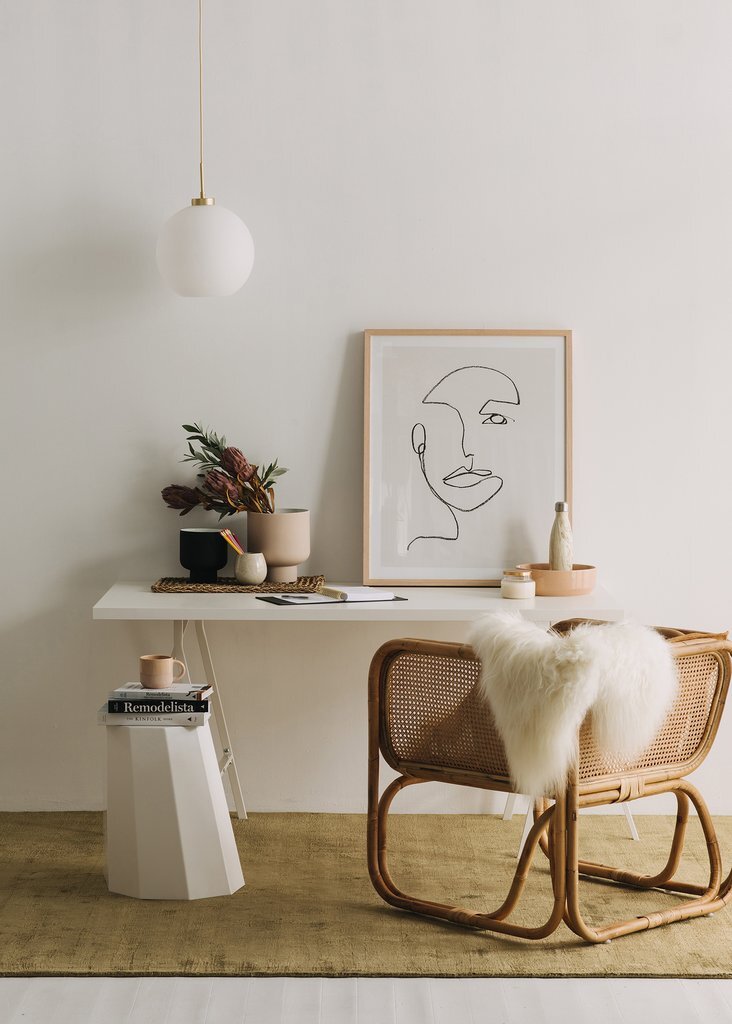
Houseplants are wonderful creatures that cleanse the air, absorb noise, bring the outside in and generally contribute to your sense of well being. There are plenty of low maintenance options out there such as Mother in Law’s tongue for a tall structural look, Devil’s Ivy for traily loveliness, and Happy Plants for scale. Try creating a vignette with plants of contrasting leaf shapes and using different sized vessels with a consistent design theme. If you feel like you might bring about an early demise to even these fuss free beauties, invest in some great quality faux plants and style them up with a great selection of pots and planters. There are some incredibly realistic options out there, including fresh touch flowers with petals that feel almost like the real thing. A vase of fresh flowers from the garden, or simply a couple of Monstera leaves will do the trick, but be sure to use a large enough vase for bigger leaves.
Check out some more ideas for Indoor Plants

I cannot stress enough just how important it is to create a space that you enjoy spending time in. Adorn your workspace walls and / or shelves with things that motivate and inspire you, things that quite simply make you happy. Inspirational quotes and aspirational images will help to remind you why you are working so hard – to pay for that incredible holiday, to give your child the best possible education, to achieve those life goals you scribbled down at New Year. It could be a large artwork that lifts you every time you see it, a small personal memento collected on a previous trip or simply a feel good photo of friends or family. Try to create a little vignette on one corner of your desk, perhaps raised on a stack of smart books or a pretty box to lift it away from the essential work space. alternatively try using favourite books, plants, images and quotes to make your very own shelfie… a little collection of well balanced and coordinated images, objects and plants will transform your space. You may want to rotate your choices to keep things fresh, especially if space is at a premium, but without a doubt, find a spot.
Don’t forget to add a couple of functional pretty things to your space. A good quality scented candle made from pure essential oils will help to avoid any stuffy office air, and dedicate a good looking water bottle and coaster to your workspace – filling it before every working day should be part of your morning routine in order to stay hydrated and focussed.
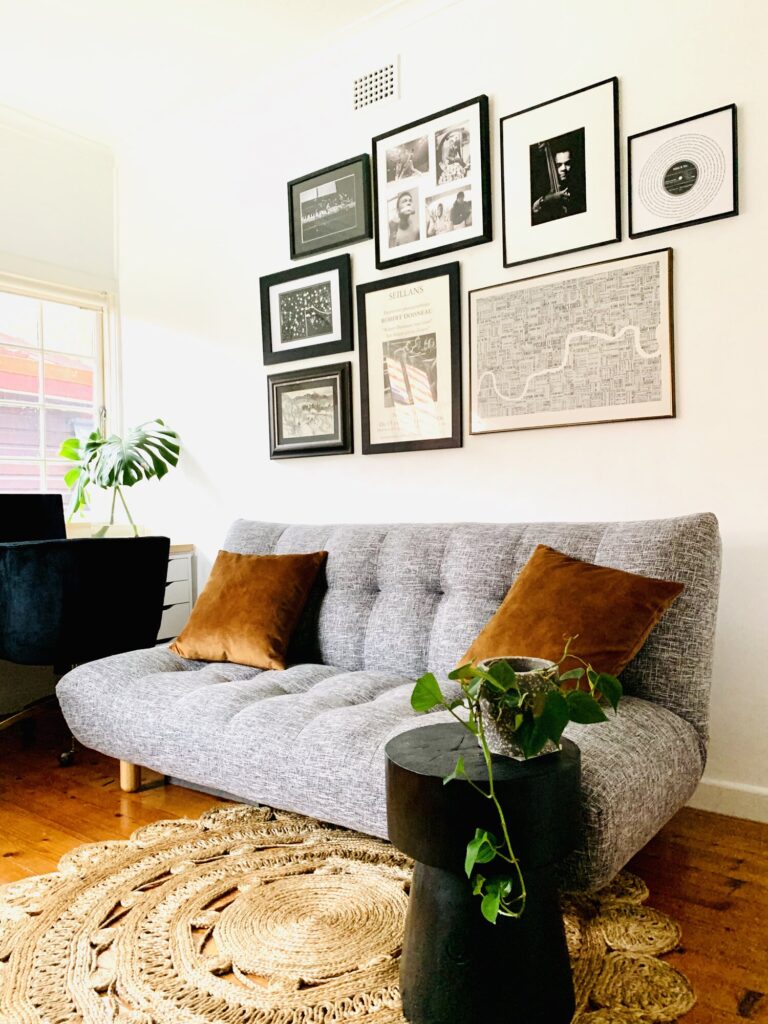
OK so you don’t need me to keep preaching to you on this one, but here’s my top 5 tips for getting through the to-do list:
And that’s it! Happy setting up, styling it up, and getting up every day feeling good about your home work space!
But if it’s all too much to get your head around – give me a call, I’d be happy to help.

24 Jul
How to hang a gallery wall
Picture hooks (various sizes, be sure to check the weight loading),
Hammer,
Spirit level,
Tape measure,
Pencil,Ruler, Set square if you have one,
Kraft paper (I have roll of 900mm x 50m Kraft Paper from Officeworks which is ideal),
Scissors.
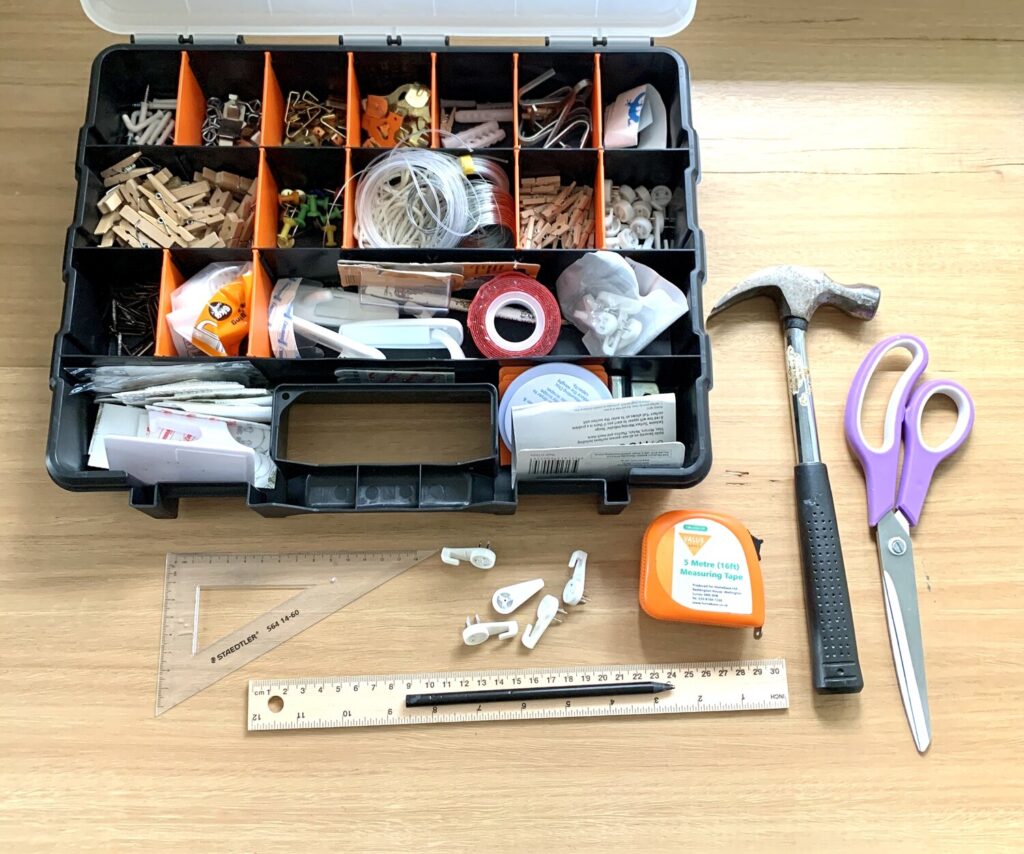
Make sure you have all the frames you plan to hang ready. Gallery walls with a consistent theme or colour palette look fabulous – perhaps you have a collection of black and white artworks and photography, botanical themed prints, or a portfolio of stunning images from your travels that you’d like to display. Spend some time deciding on your preferred style of gallery – will it be a formal grid, coordinated artworks or mis matched images and objets?
Low cost frames can be found in Kmart, Spotlight or Target, and you will also find decent quality frames in places like Country Road and West Elm, and Temple & Webster has, as always, a huge range. Gallery wall frame packs are available at many retailers to get you started if you are able to print images to fit, and will come with an idea of how to best lay them out. There are also a wealth of online framing companies such as Frames Now who have an enormous range of styles and sizes and can also offer custom framing and replacement glass or mat boards, and even print to stretched canvas. Try not to go too matchy matchy with frames unless you are aiming for a formal grid style, in which case identical frames are the best option. All black frames in different shapes and sizes work well together with a consistent theme of images, and conversely a variety of finishes gives a more relaxed look.
If you don’t already have a collection there are some great retailers out there with gallery walls ready to go, frames and all, like this one from Desenio. If your gallery is to be located alongside furniture be sure to change up your accessories to complement the tones in the artworks to complete the look.

First of all you need to measure the space – I wanted my gallery centred above a sofa bed so I took the length of the sofa and arranged my artworks within it. Had the space been available I would have liked to offset it – don’t forget to consider this as an option, for example one large singular artwork looks great set off to one side of a bed or sofa, and the same can apply to a gallery wall. Leave a 30cm gap between the top of a sofa and the frames to avoid them getting knocked out of place and to give them room to be admired. The centre of the arrangement should be at eye level for optimum viewing so measure the distance between the bottom of the lowest frame (ie. 30cm above the sofa if this is where the gallery is to be positioned) and eye level – generally about 175-185cm above floor level.
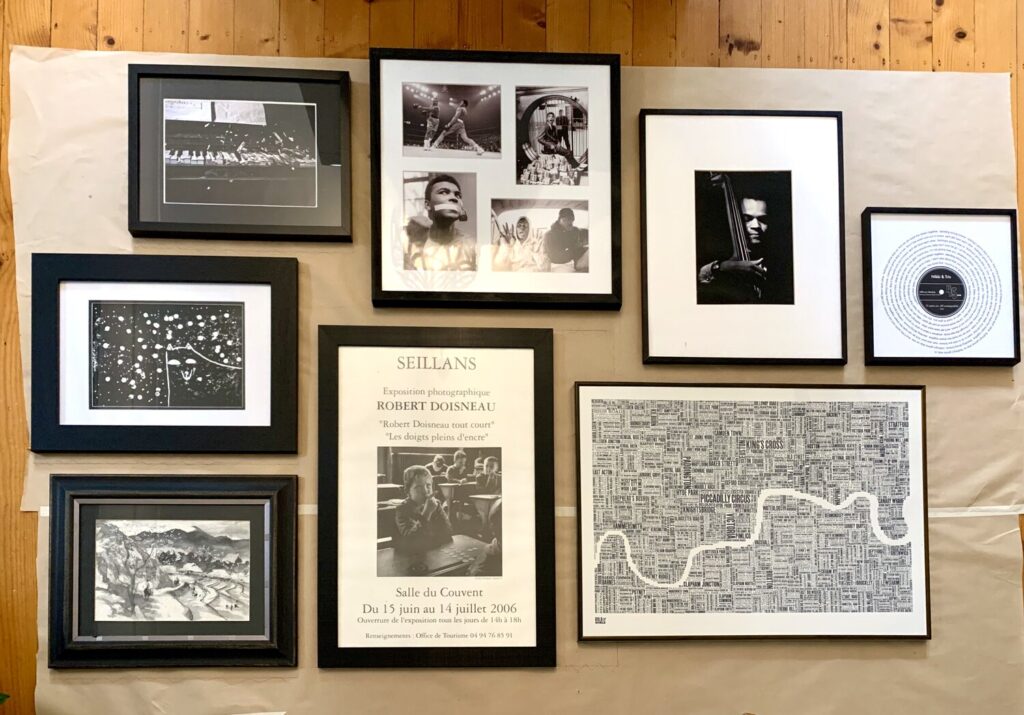
Lay out a large piece of kraft paper big enough to cover the wall space – you may need to tape the paper together to get a large enough section. Arrange your frames on top of the paper, building the layout out from one or two larger centrepieces. Take a photo on your phone and then move the arrangement around a few times until you find the composition that works for you.
Use your ruler and / or set square to ensure your frames are evenly spaced – personally I find this easier to achieve by drawing around my frames on my large piece of kraft paper rather than using individual paper cut outs for each frame. You can also check your lines are straight and double check spacing easily once all the frames are drawn on in your chosen layout.
Next measure the hanging point on the back of each frame and mark it on the paper – if there is picture wire pull it taught to where it will sit when hung. Take your time to make sure the nail or hook is placed at the correct point or all your work on the spacing between frames will be out of kilter.
Once you have all your frames drawn, correctly spaced, with hanging points marked on, put the kraft paper on the wall in the appropriate position. Check you are happy with the arrangement and ask yourself if it fills the space appropriately. Now for the fun bit! Put your hooks or nails in at the marked spots and hang all your picture while the kraft paper is still on the wall. This is your final opportunity to ensure you have everything just as you want it – it will be much easier to mark adjustments on the paper. If you are happy with everything, remove the frames, carefully take down the paper and re-hang your pictures in place, using a spirit level to ensure they are all perfectly level. And voila! A fabulous gallery wall has appeared!
